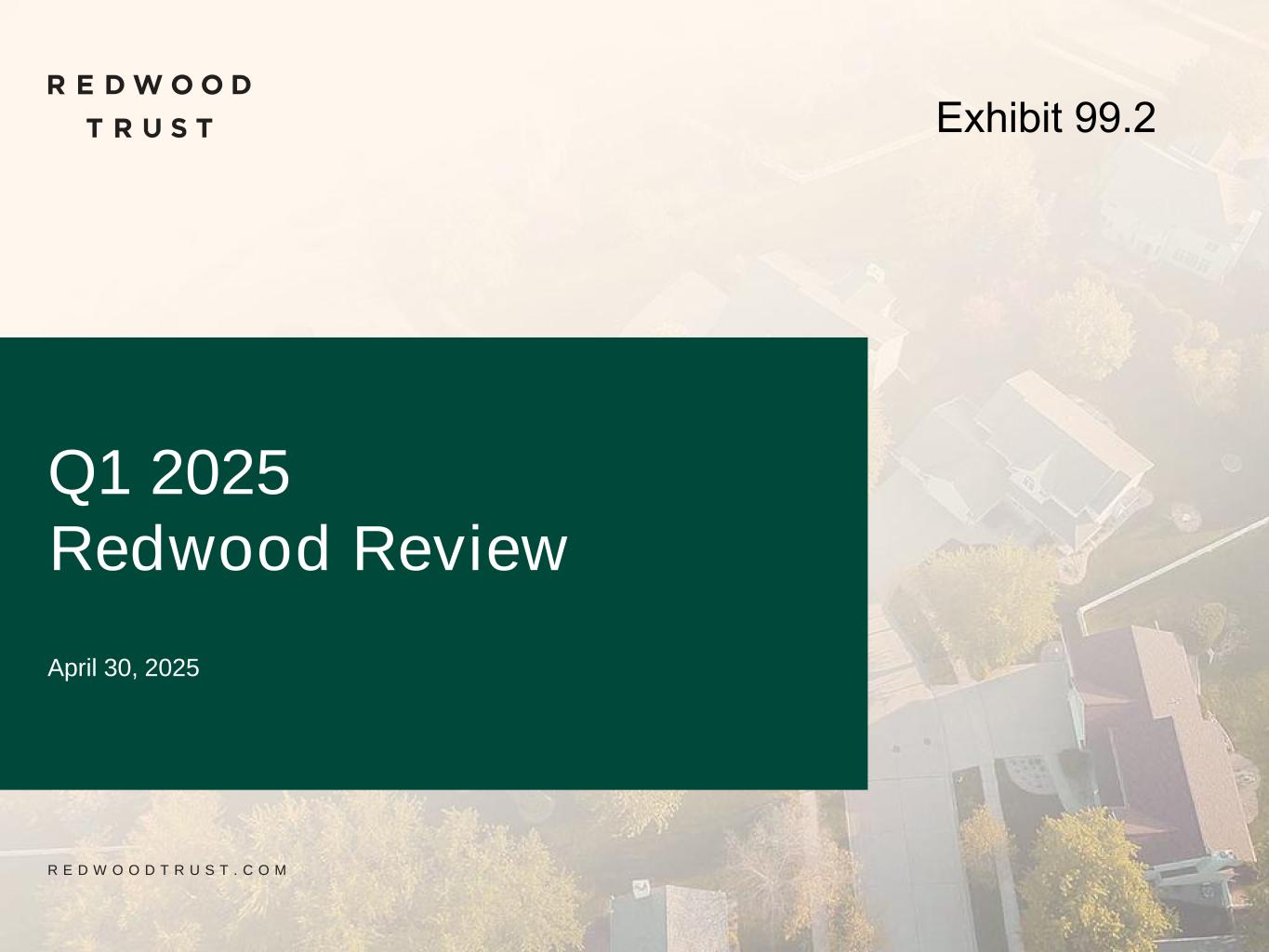
R E D W O O D T R U S T . C O M Q1 2025 Redwood Review April 30, 2025 Exhibit 99.2
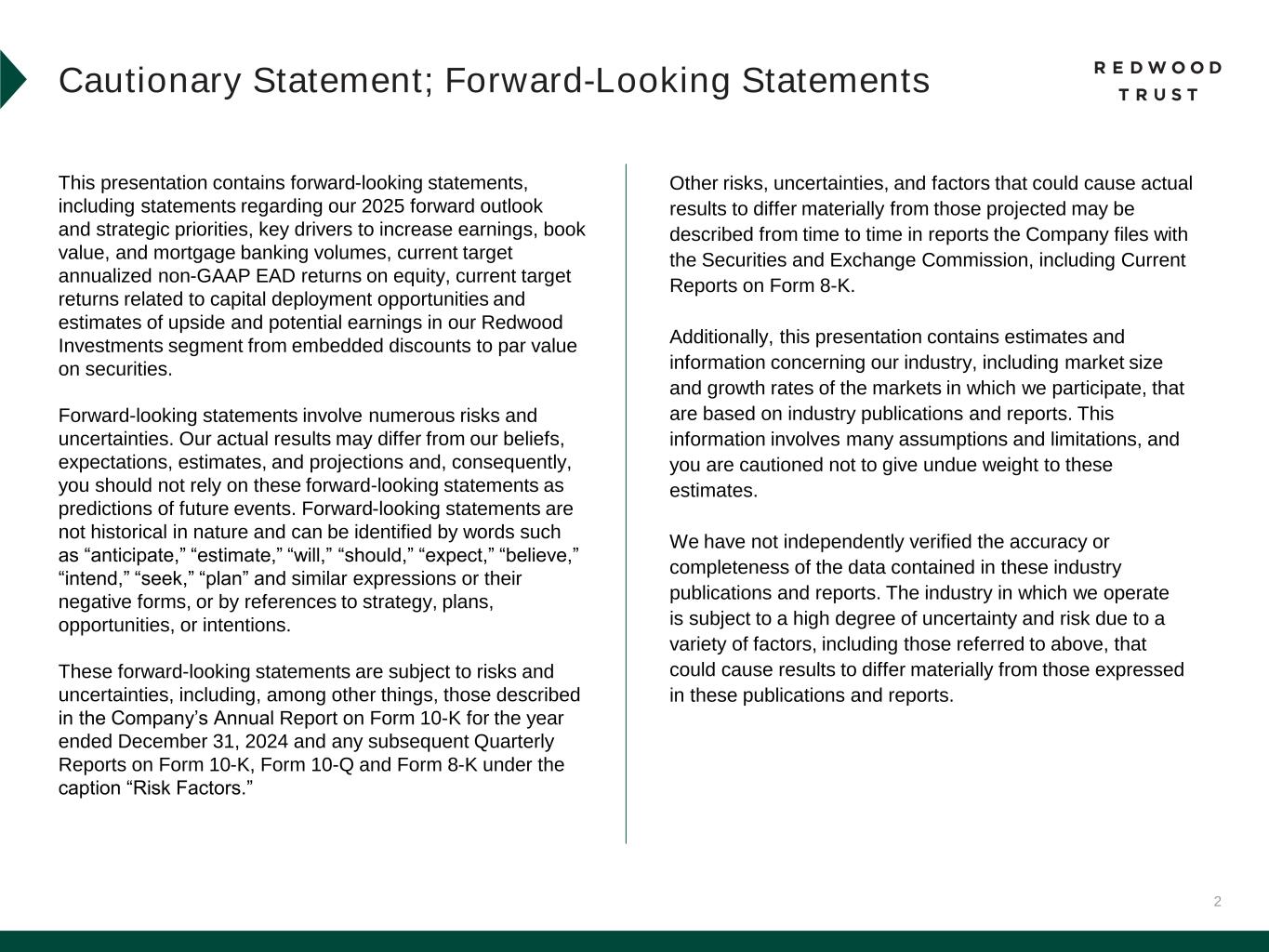
2 This presentation contains forward-looking statements, including statements regarding our 2025 forward outlook and strategic priorities, key drivers to increase earnings, book value, and mortgage banking volumes, current target annualized non-GAAP EAD returns on equity, current target returns related to capital deployment opportunities and estimates of upside and potential earnings in our Redwood Investments segment from embedded discounts to par value on securities. Forward-looking statements involve numerous risks and uncertainties. Our actual results may differ from our beliefs, expectations, estimates, and projections and, consequently, you should not rely on these forward-looking statements as predictions of future events. Forward-looking statements are not historical in nature and can be identified by words such as “anticipate,” “estimate,” “will,” “should,” “expect,” “believe,” “intend,” “seek,” “plan” and similar expressions or their negative forms, or by references to strategy, plans, opportunities, or intentions. These forward-looking statements are subject to risks and uncertainties, including, among other things, those described in the Company’s Annual Report on Form 10-K for the year ended December 31, 2024 and any subsequent Quarterly Reports on Form 10-K, Form 10-Q and Form 8-K under the caption “Risk Factors.” Cautionary Statement; Forward-Looking Statements Other risks, uncertainties, and factors that could cause actual results to differ materially from those projected may be described from time to time in reports the Company files with the Securities and Exchange Commission, including Current Reports on Form 8-K. Additionally, this presentation contains estimates and information concerning our industry, including market size and growth rates of the markets in which we participate, that are based on industry publications and reports. This information involves many assumptions and limitations, and you are cautioned not to give undue weight to these estimates. We have not independently verified the accuracy or completeness of the data contained in these industry publications and reports. The industry in which we operate is subject to a high degree of uncertainty and risk due to a variety of factors, including those referred to above, that could cause results to differ materially from those expressed in these publications and reports.
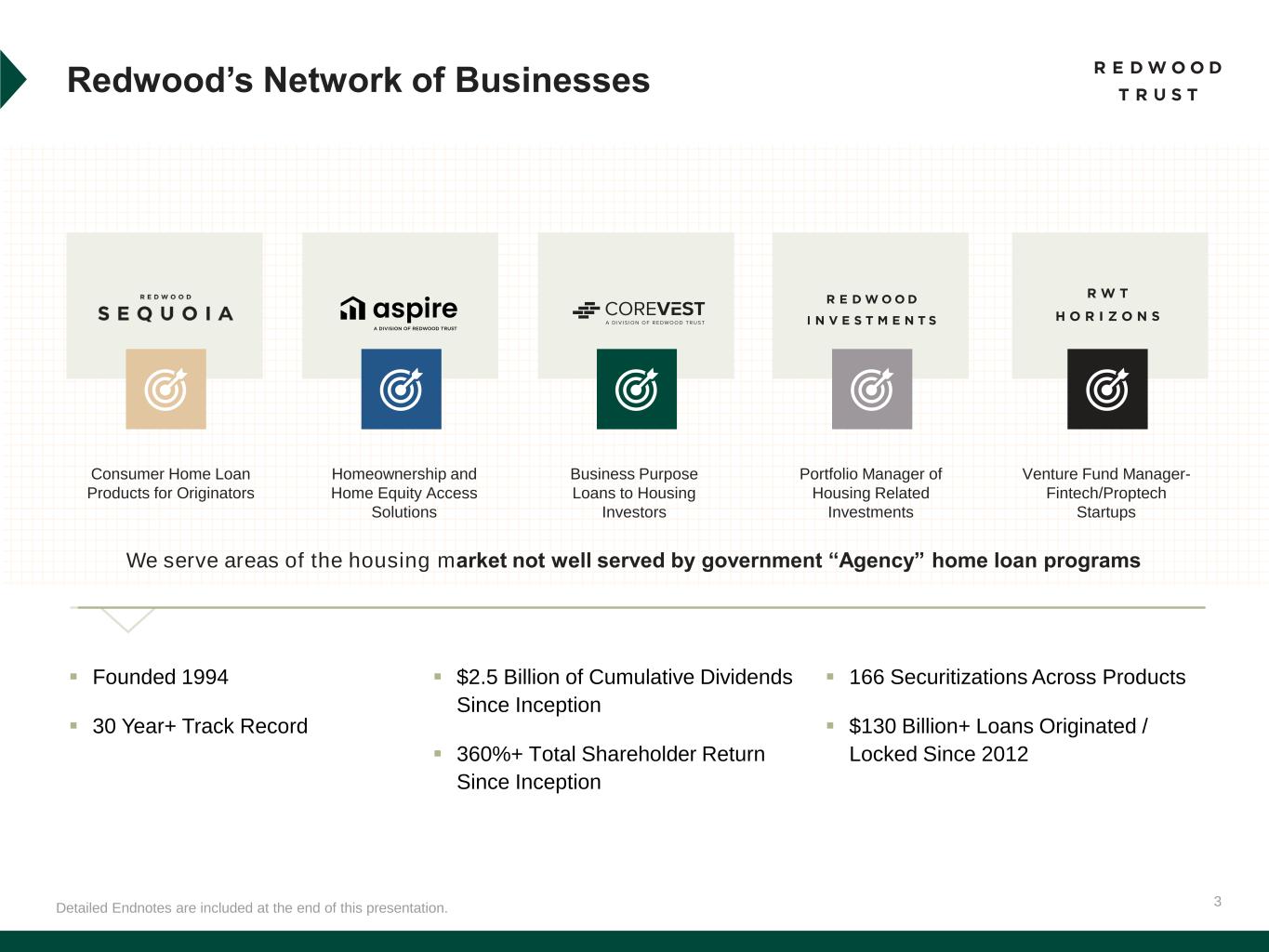
3 Redwood’s Network of Businesses We serve areas of the housing market not well served by government “Agency” home loan programs ▪ Founded 1994 ▪ 30 Year+ Track Record ▪ $2.5 Billion of Cumulative Dividends Since Inception ▪ 360%+ Total Shareholder Return Since Inception ▪ 166 Securitizations Across Products ▪ $130 Billion+ Loans Originated / Locked Since 2012 Consumer Home Loan Products for Originators Business Purpose Loans to Housing Investors Portfolio Manager of Housing Related Investments Venture Fund Manager- Fintech/Proptech Startups Homeownership and Home Equity Access Solutions Detailed Endnotes are included at the end of this presentation.
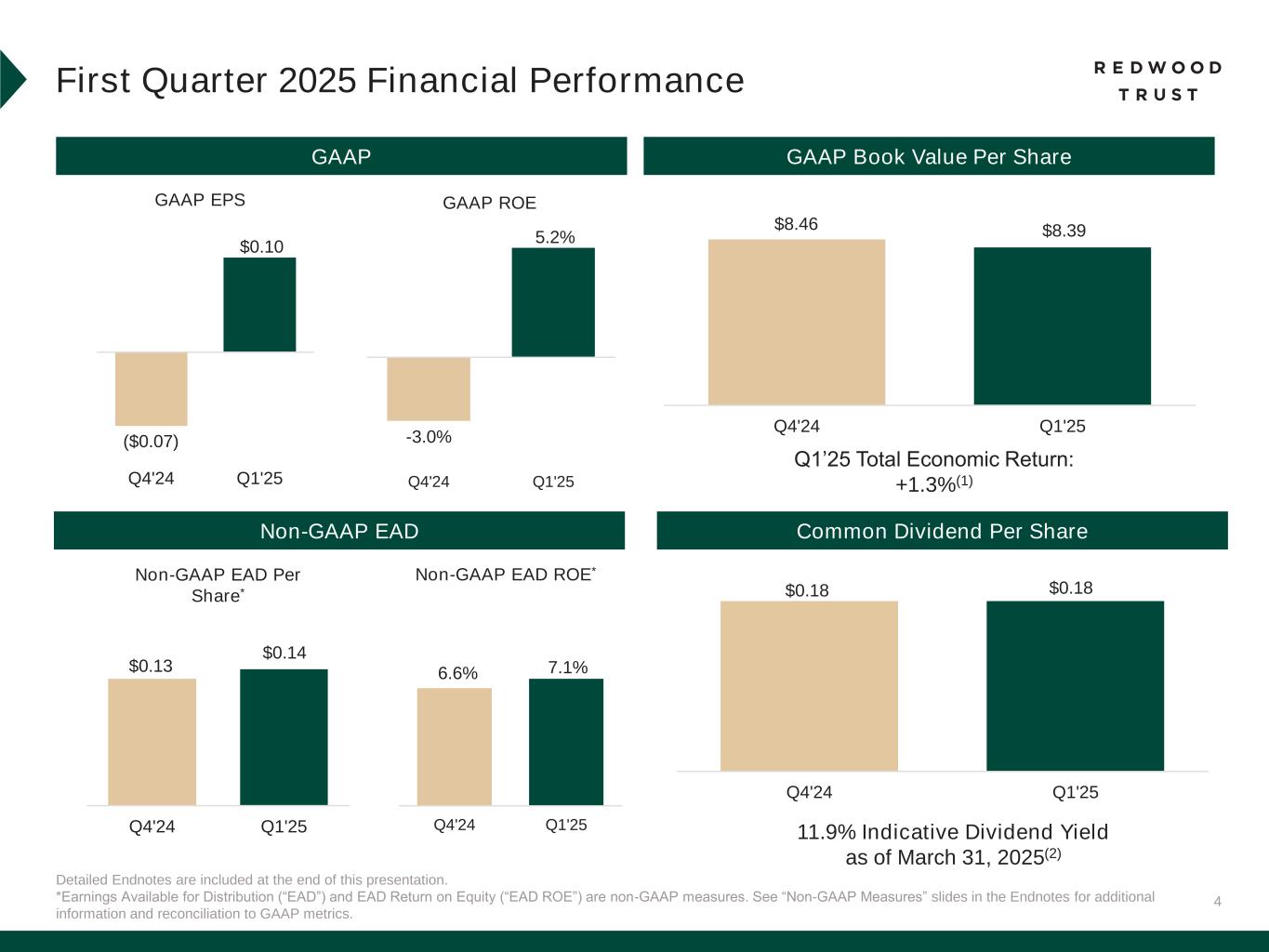
4 Detailed Endnotes are included at the end of this presentation. *Earnings Available for Distribution (“EAD”) and EAD Return on Equity (“EAD ROE”) are non-GAAP measures. See “Non-GAAP Measures” slides in the Endnotes for additional information and reconciliation to GAAP metrics. First Quarter 2025 Financial Performance Q1’25 Total Economic Return: +1.3%(1) GAAP ROE Non-GAAP EAD ROE* GAAP EPS GAAP GAAP Book Value Per Share Common Dividend Per ShareNon-GAAP EAD Non-GAAP EAD Per Share* $8.46 $8.39 Q4'24 Q1'25 $0.13 $0.14 Q4'24 Q1'25 ($0.07) $0.10 Q4'24 Q1'25 -3.0% 5.2% Q4'24 Q1'25 6.6% 7.1% Q4'24 Q1'25 11.9% Indicative Dividend Yield as of March 31, 2025(2) $0.18 $0.18 Q4'24 Q1'25
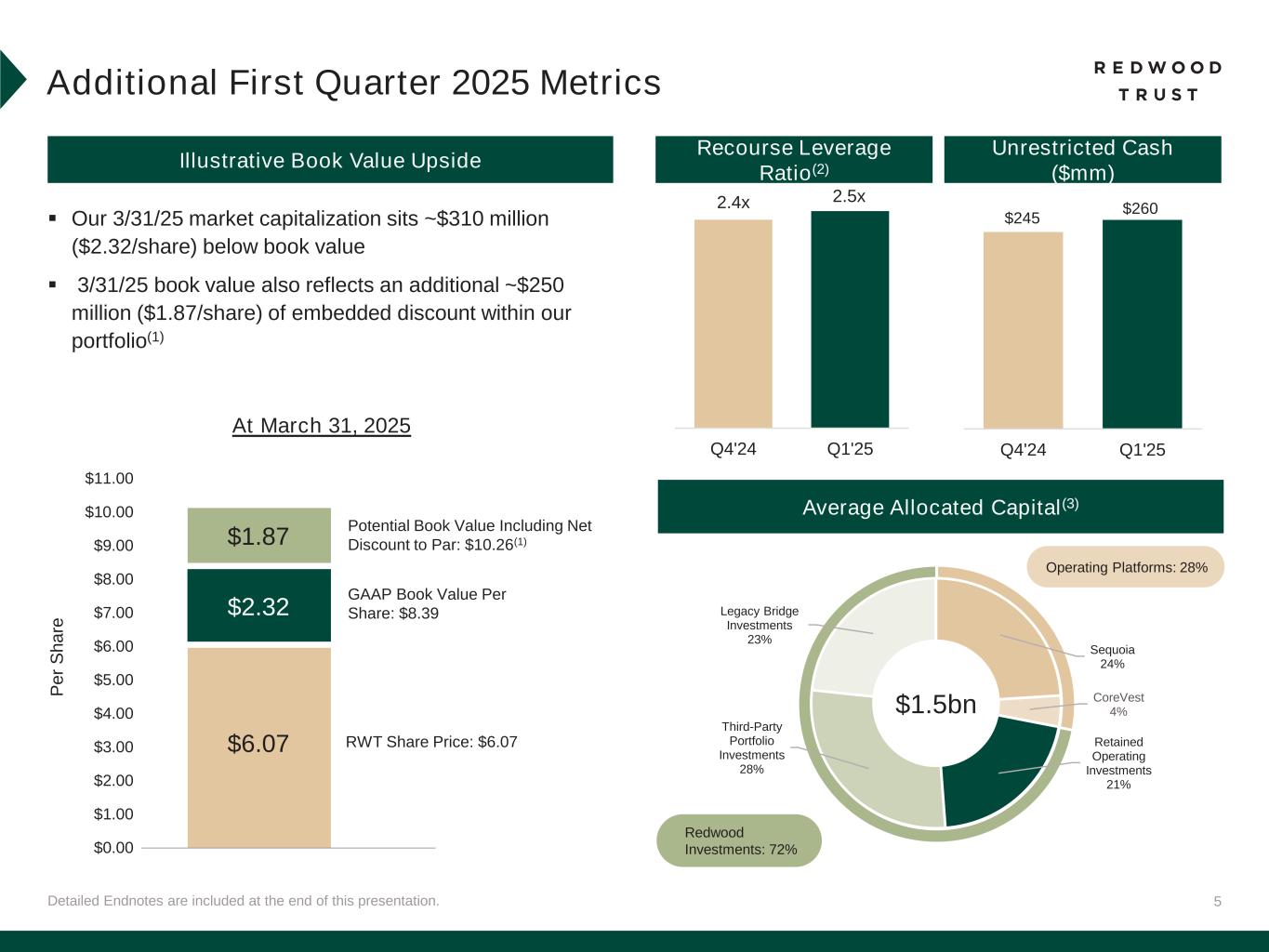
5Detailed Endnotes are included at the end of this presentation. Additional First Quarter 2025 Metrics Recourse Leverage Ratio(2) Unrestricted Cash ($mm) Average Allocated Capital(3) Illustrative Book Value Upside ▪ Our 3/31/25 market capitalization sits ~$310 million ($2.32/share) below book value ▪ 3/31/25 book value also reflects an additional ~$250 million ($1.87/share) of embedded discount within our portfolio(1) $0.00 $1.00 $2.00 $3.00 $4.00 $5.00 $6.00 $7.00 $8.00 $9.00 $10.00 $11.00 GAAP Book Value Per Share: $8.39 Potential Book Value Including Net Discount to Par: $10.26(1) RWT Share Price: $6.07 $6.07 $2.32 $1.87 P e r S h a re Sequoia 24% CoreVest 4% Retained Operating Investments 21% Third-Party Portfolio Investments 28% Legacy Bridge Investments 23% Operating Platforms: 28% $1.5bn Redwood Investments: 72% 2.4x 2.5x Q4'24 Q1'25 $245 $260 Q4'24 Q1'25 At March 31, 2025
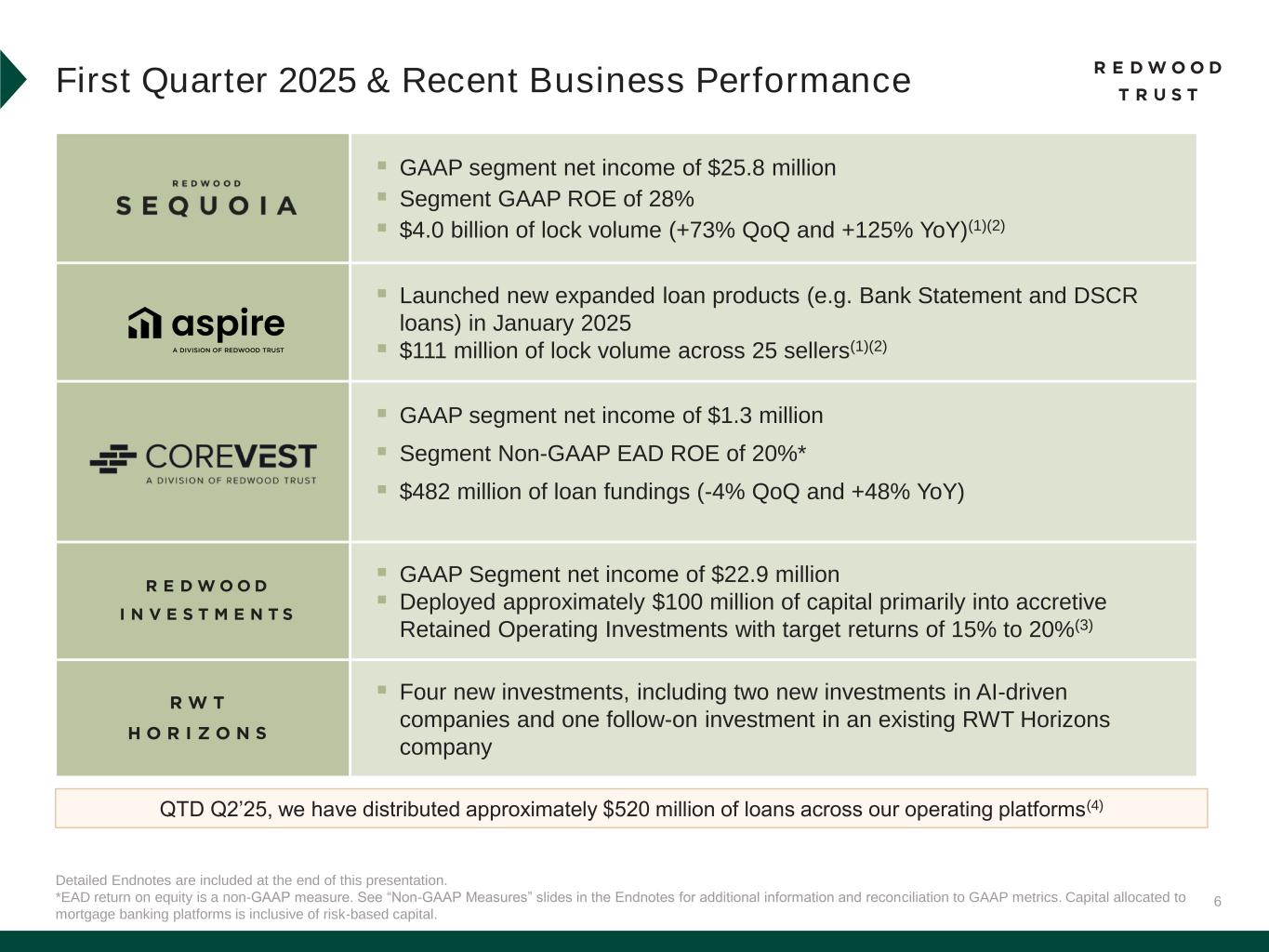
6 ▪ GAAP segment net income of $25.8 million ▪ Segment GAAP ROE of 28% ▪ $4.0 billion of lock volume (+73% QoQ and +125% YoY)(1)(2) ▪ Launched new expanded loan products (e.g. Bank Statement and DSCR loans) in January 2025 ▪ $111 million of lock volume across 25 sellers(1)(2) ▪ GAAP segment net income of $1.3 million ▪ Segment Non-GAAP EAD ROE of 20%* ▪ $482 million of loan fundings (-4% QoQ and +48% YoY) ▪ GAAP Segment net income of $22.9 million ▪ Deployed approximately $100 million of capital primarily into accretive Retained Operating Investments with target returns of 15% to 20%(3) ▪ Four new investments, including two new investments in AI-driven companies and one follow-on investment in an existing RWT Horizons company First Quarter 2025 & Recent Business Performance Detailed Endnotes are included at the end of this presentation. *EAD return on equity is a non-GAAP measure. See “Non-GAAP Measures” slides in the Endnotes for additional information and reconciliation to GAAP metrics. Capital allocated to mortgage banking platforms is inclusive of risk-based capital. QTD Q2’25, we have distributed approximately $520 million of loans across our operating platforms(4)
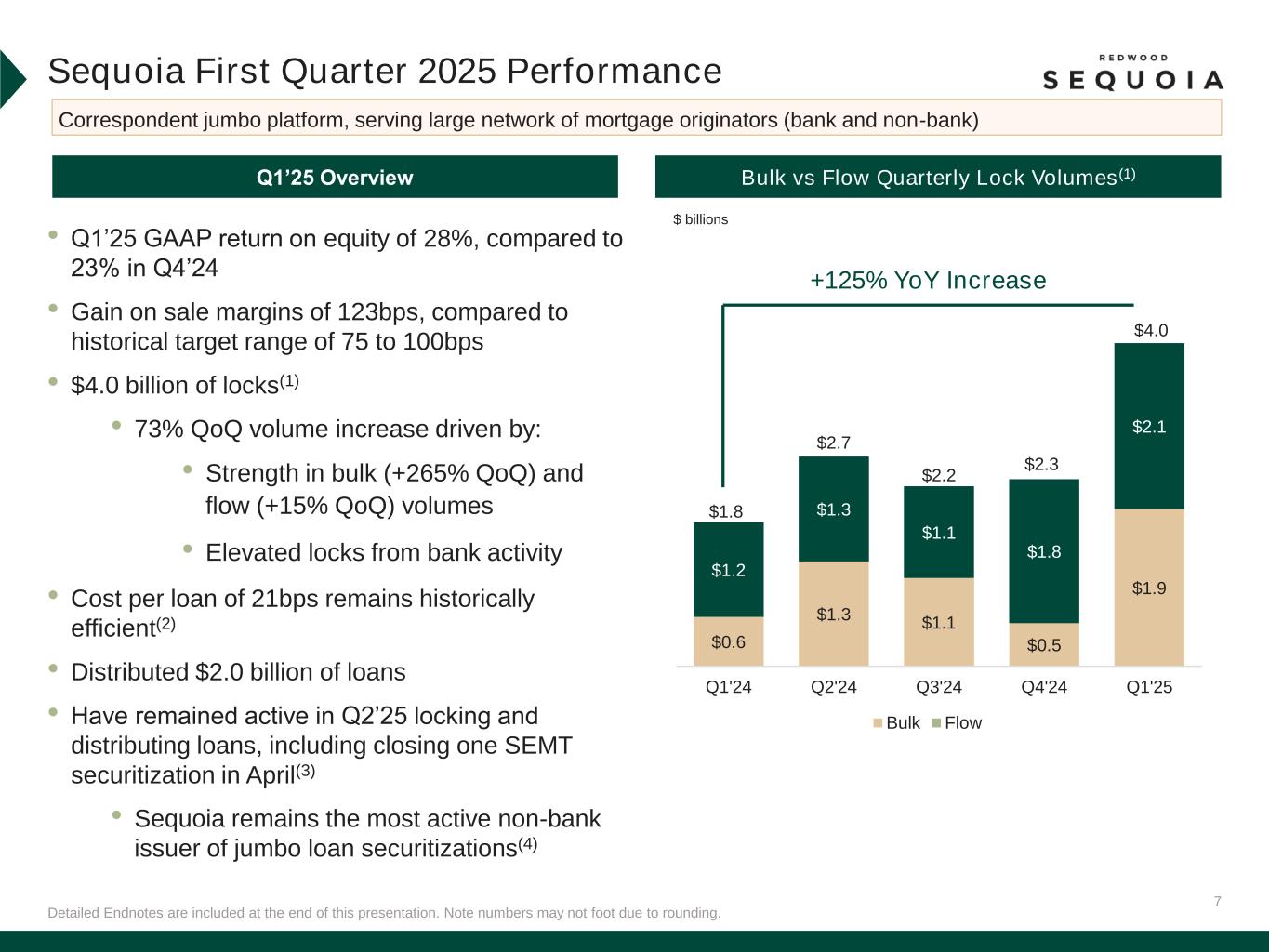
7 Detailed Endnotes are included at the end of this presentation. Note numbers may not foot due to rounding. Sequoia First Quarter 2025 Performance Bulk vs Flow Quarterly Lock Volumes(1) $ billions • Q1’25 GAAP return on equity of 28%, compared to 23% in Q4’24 • Gain on sale margins of 123bps, compared to historical target range of 75 to 100bps • $4.0 billion of locks(1) • 73% QoQ volume increase driven by: • Strength in bulk (+265% QoQ) and flow (+15% QoQ) volumes • Elevated locks from bank activity • Cost per loan of 21bps remains historically efficient(2) • Distributed $2.0 billion of loans • Have remained active in Q2’25 locking and distributing loans, including closing one SEMT securitization in April(3) • Sequoia remains the most active non-bank issuer of jumbo loan securitizations(4) Q1’25 Overview +125% YoY Increase Correspondent jumbo platform, serving large network of mortgage originators (bank and non-bank) $0.6 $1.3 $1.1 $0.5 $1.9 $1.2 $1.3 $1.1 $1.8 $2.1 $1.8 $2.7 $2.2 $2.3 $4.0 Q1'24 Q2'24 Q3'24 Q4'24 Q1'25 Bulk Flow
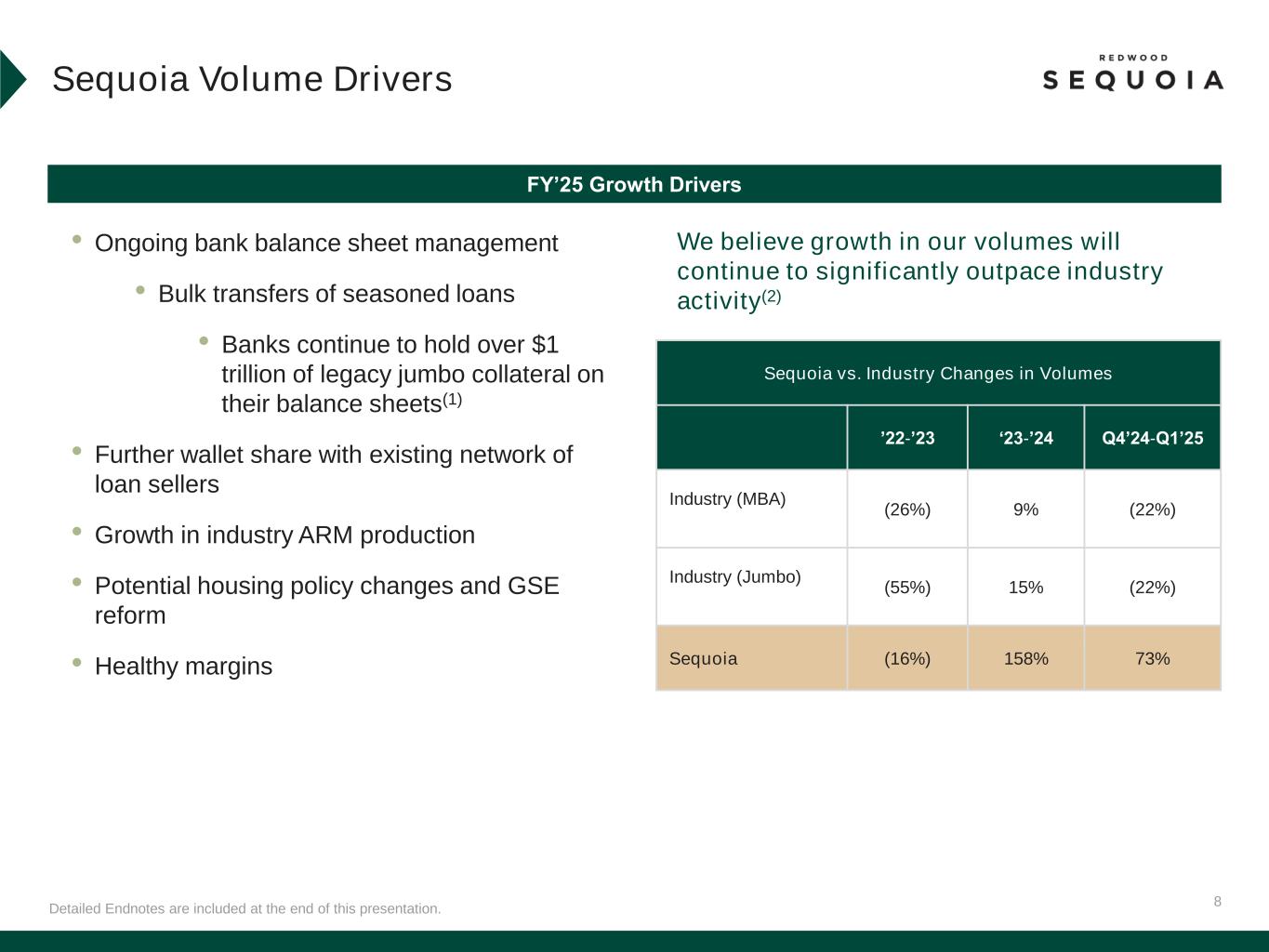
8 Sequoia Volume Drivers Detailed Endnotes are included at the end of this presentation. FY’25 Growth Drivers • Ongoing bank balance sheet management • Bulk transfers of seasoned loans • Banks continue to hold over $1 trillion of legacy jumbo collateral on their balance sheets(1) • Further wallet share with existing network of loan sellers • Growth in industry ARM production • Potential housing policy changes and GSE reform • Healthy margins We believe growth in our volumes will continue to significantly outpace industry activity(2) Sequoia vs. Industry Changes in Volumes ’22-’23 ‘23-’24 Q4’24-Q1’25 Industry (MBA) (26%) 9% (22%) Industry (Jumbo) (55%) 15% (22%) Sequoia (16%) 158% 73%
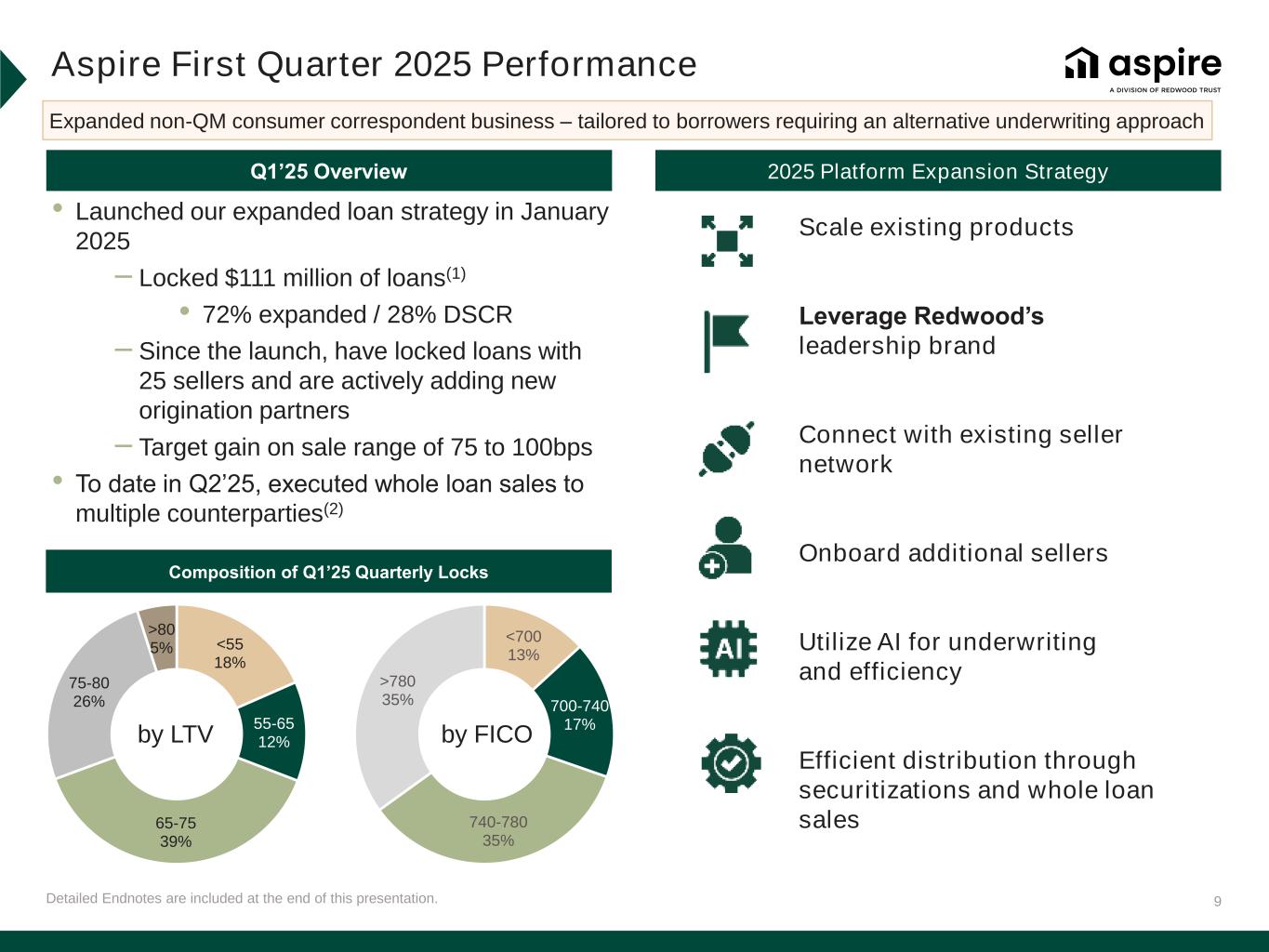
9 Aspire First Quarter 2025 Performance Composition of Q1’25 Quarterly Locks Q1’25 Overview Detailed Endnotes are included at the end of this presentation. 2025 Platform Expansion Strategy Scale existing products Leverage Redwood’s leadership brand Connect with existing seller network Onboard additional sellers Utilize AI for underwriting and efficiency Efficient distribution through securitizations and whole loan sales <700 13% 700-740 17% 740-780 35% >780 35% by LTV by FICO Expanded non-QM consumer correspondent business – tailored to borrowers requiring an alternative underwriting approach • Launched our expanded loan strategy in January 2025 – Locked $111 million of loans(1) • 72% expanded / 28% DSCR – Since the launch, have locked loans with 25 sellers and are actively adding new origination partners – Target gain on sale range of 75 to 100bps • To date in Q2’25, executed whole loan sales to multiple counterparties(2) <55 18% 55-65 12% 65-75 39% 75-80 26% >80 5%
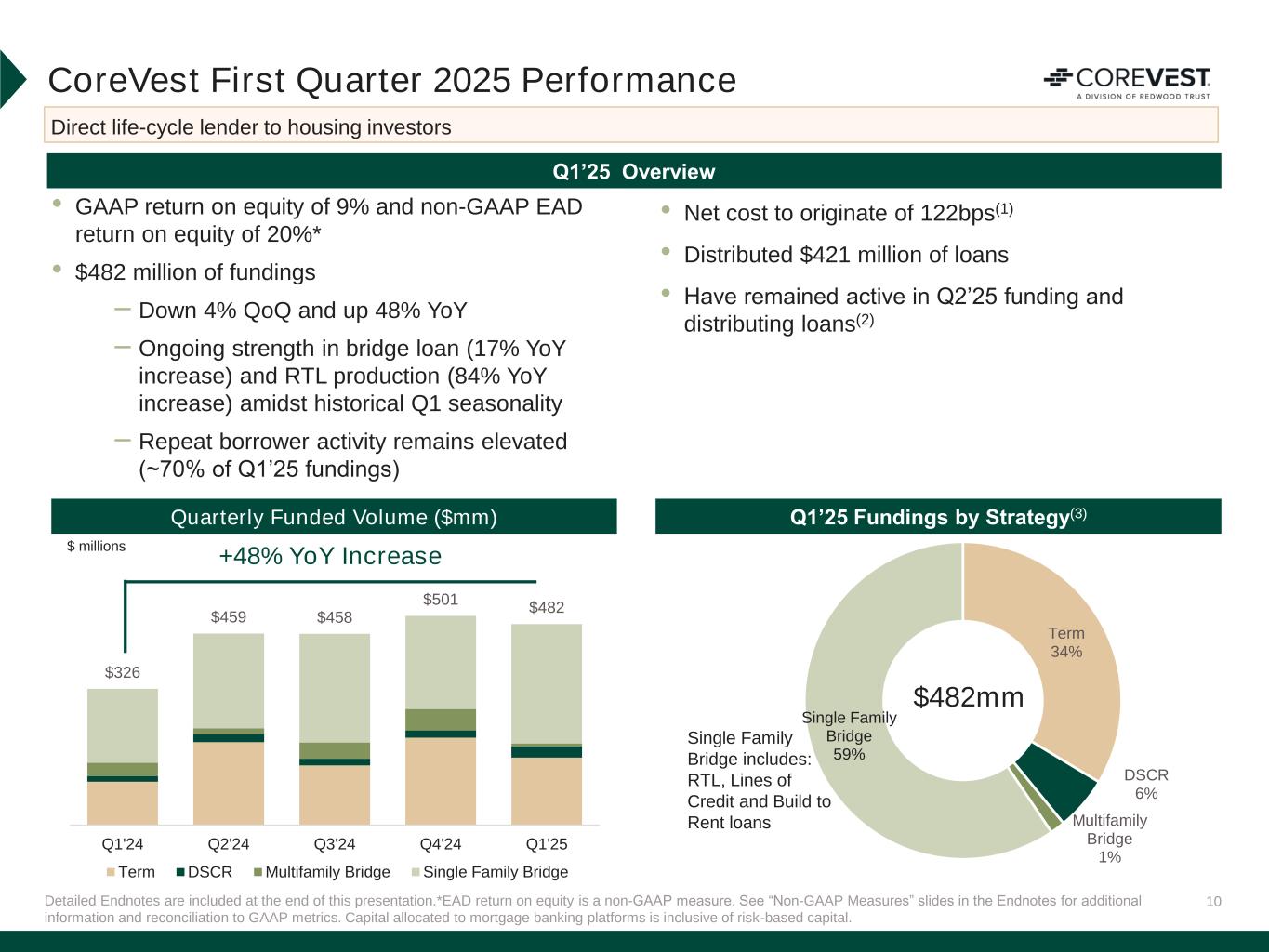
10 • GAAP return on equity of 9% and non-GAAP EAD return on equity of 20%* • $482 million of fundings – Down 4% QoQ and up 48% YoY – Ongoing strength in bridge loan (17% YoY increase) and RTL production (84% YoY increase) amidst historical Q1 seasonality – Repeat borrower activity remains elevated (~70% of Q1’25 fundings) CoreVest First Quarter 2025 Performance Q1’25 Overview Quarterly Funded Volume ($mm) Detailed Endnotes are included at the end of this presentation.*EAD return on equity is a non-GAAP measure. See “Non-GAAP Measures” slides in the Endnotes for additional information and reconciliation to GAAP metrics. Capital allocated to mortgage banking platforms is inclusive of risk-based capital. +48% YoY Increase $ millions Q1’25 Fundings by Strategy(3) • Net cost to originate of 122bps(1) • Distributed $421 million of loans • Have remained active in Q2’25 funding and distributing loans(2) Direct life-cycle lender to housing investors Term 34% DSCR 6% Multifamily Bridge 1% Single Family Bridge 59% Single Family Bridge includes: RTL, Lines of Credit and Build to Rent loans $482mm $326 $459 $458 $501 $482 Q1'24 Q2'24 Q3'24 Q4'24 Q1'25 Term DSCR Multifamily Bridge Single Family Bridge
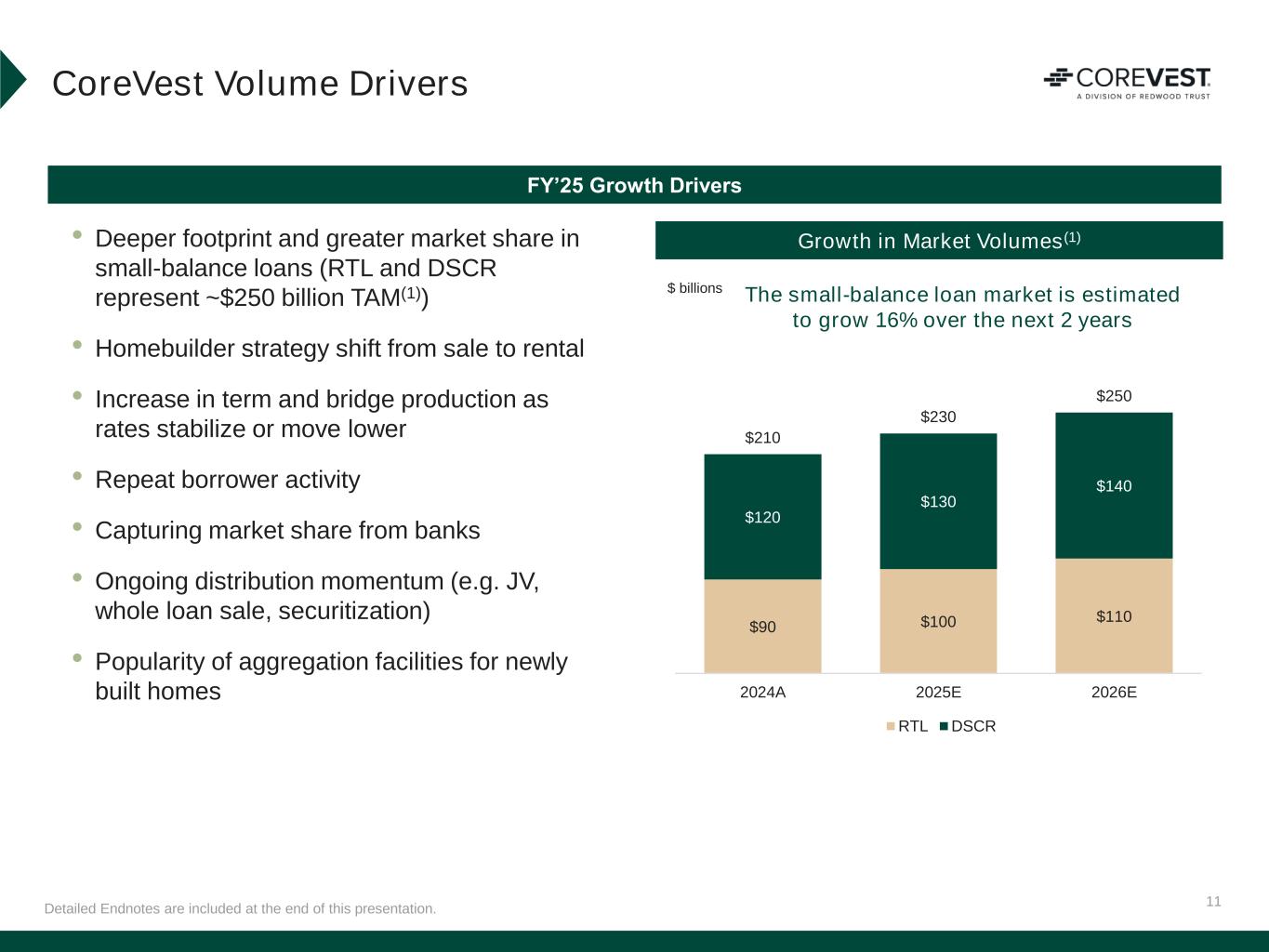
11 CoreVest Volume Drivers Detailed Endnotes are included at the end of this presentation. FY’25 Growth Drivers • Deeper footprint and greater market share in small-balance loans (RTL and DSCR represent ~$250 billion TAM(1)) • Homebuilder strategy shift from sale to rental • Increase in term and bridge production as rates stabilize or move lower • Repeat borrower activity • Capturing market share from banks • Ongoing distribution momentum (e.g. JV, whole loan sale, securitization) • Popularity of aggregation facilities for newly built homes Growth in Market Volumes(1) $ billions The small-balance loan market is estimated to grow 16% over the next 2 years $90 $100 $110 $120 $130 $140 $210 $230 $250 2024A 2025E 2026E RTL DSCR
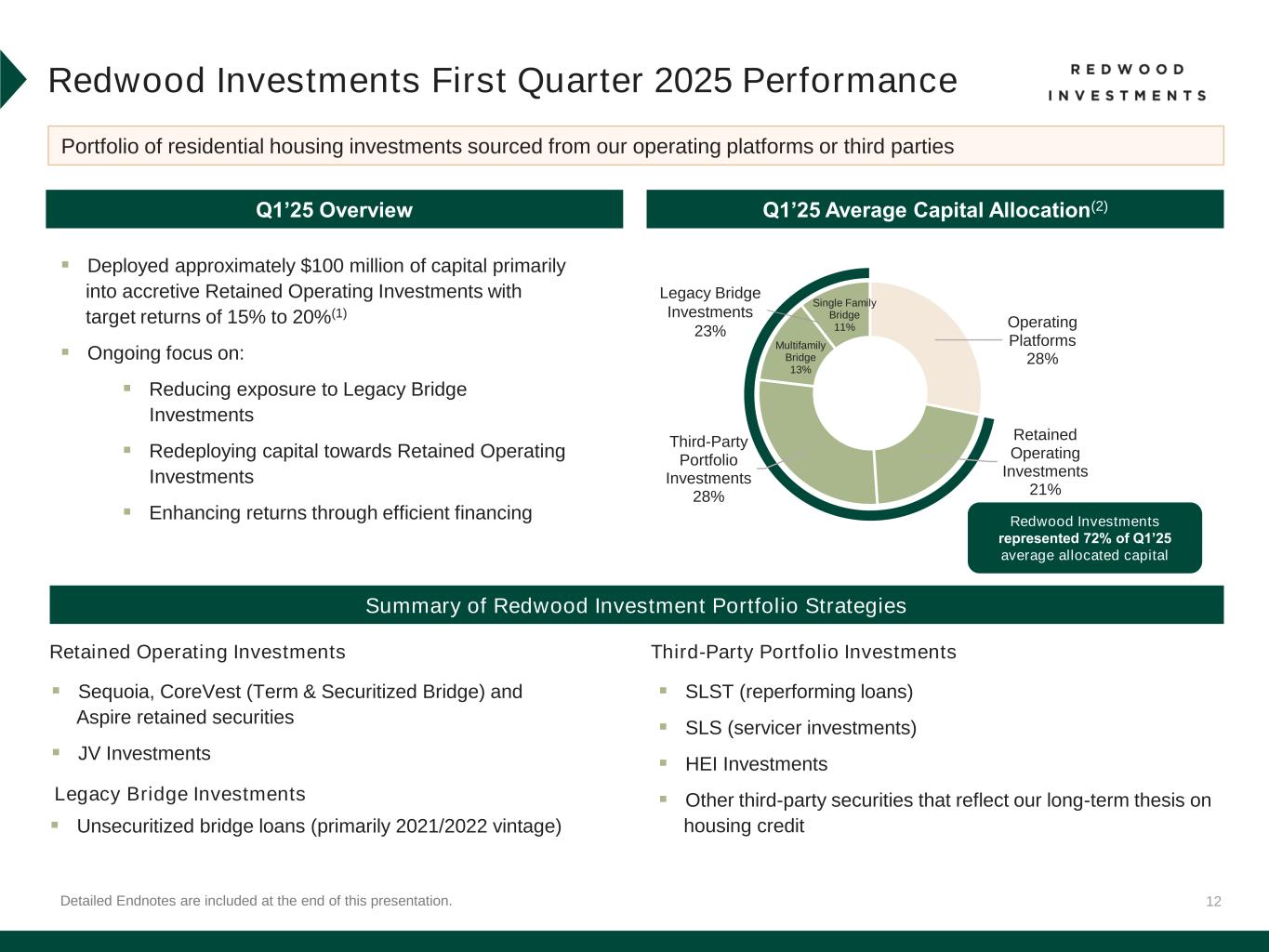
12 Redwood Investments First Quarter 2025 Performance Operating Platforms 28% Retained Operating Investments 21% Third-Party Portfolio Investments 28% Multifamily Bridge 13% Single Family Bridge 11% Detailed Endnotes are included at the end of this presentation. Retained Operating Investments ▪ Sequoia, CoreVest (Term & Securitized Bridge) and Aspire retained securities ▪ JV Investments Summary of Redwood Investment Portfolio Strategies Q1’25 Overview Portfolio of residential housing investments sourced from our operating platforms or third parties ▪ Deployed approximately $100 million of capital primarily into accretive Retained Operating Investments with target returns of 15% to 20%(1) ▪ Ongoing focus on: ▪ Reducing exposure to Legacy Bridge Investments ▪ Redeploying capital towards Retained Operating Investments ▪ Enhancing returns through efficient financing Third-Party Portfolio Investments Legacy Bridge Investments ▪ SLST (reperforming loans) ▪ SLS (servicer investments) ▪ HEI Investments ▪ Other third-party securities that reflect our long-term thesis on housing credit▪ Unsecuritized bridge loans (primarily 2021/2022 vintage) Q1’25 Average Capital Allocation(2) Legacy Bridge Investments 23% Redwood Investments represented 72% of Q1’25 average allocated capital
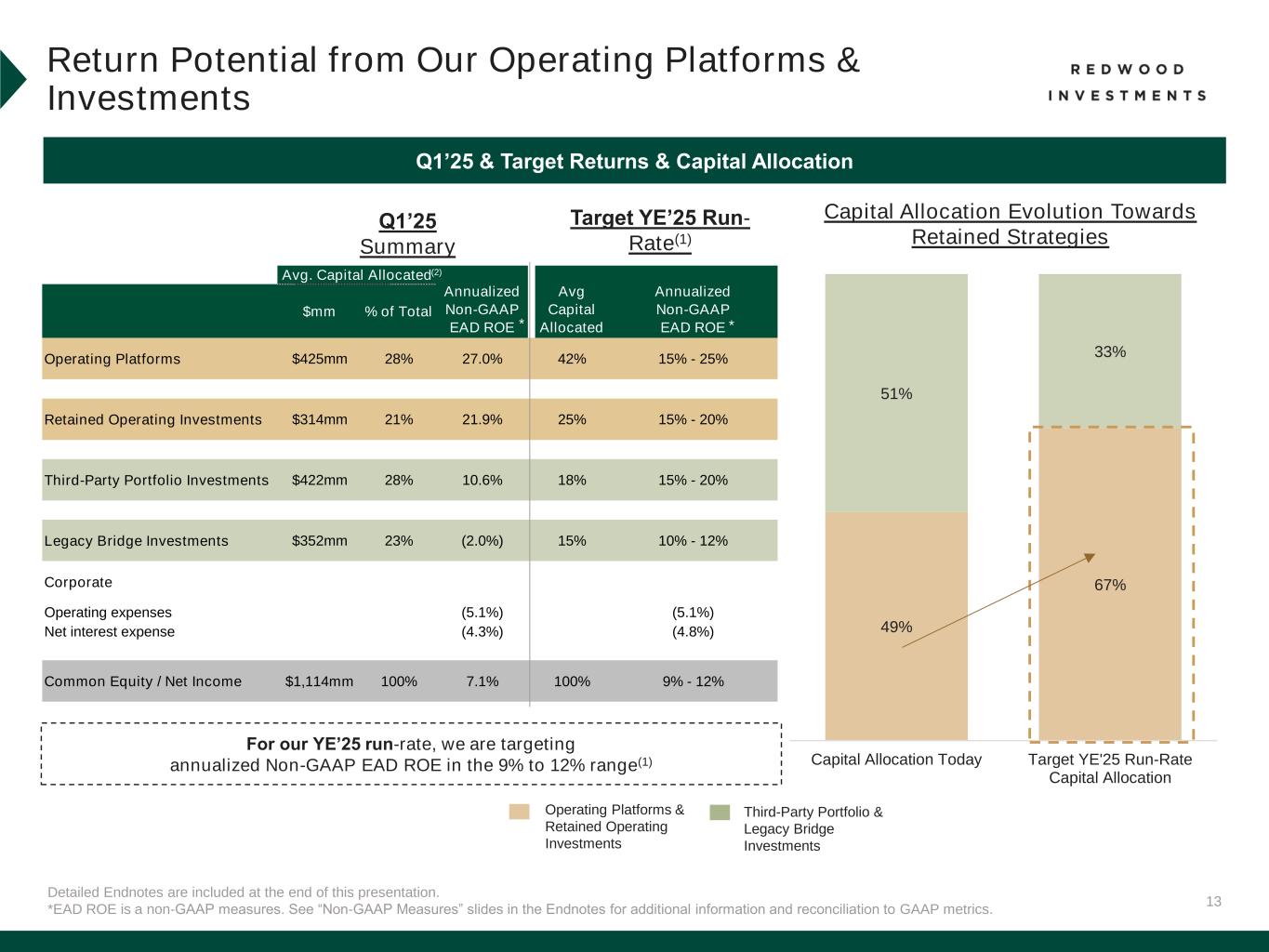
13 Avg. Capital Allocated $mm % of Total Annualized Non-GAAP EAD ROE Avg Capital Allocated Annualized Non-GAAP EAD ROE Operating Platforms $425mm 28% 27.0% 42% 15% - 25% Retained Operating Investments $314mm 21% 21.9% 25% 15% - 20% Third-Party Portfolio Investments $422mm 28% 10.6% 18% 15% - 20% Legacy Bridge Investments $352mm 23% (2.0%) 15% 10% - 12% Corporate Operating expenses (5.1%) (5.1%) Net interest expense (4.3%) (4.8%) Common Equity / Net Income $1,114mm 100% 7.1% 100% 9% - 12% Detailed Endnotes are included at the end of this presentation. *EAD ROE is a non-GAAP measures. See “Non-GAAP Measures” slides in the Endnotes for additional information and reconciliation to GAAP metrics. Return Potential from Our Operating Platforms & Investments (1)Q1’25 & Target Returns & Capital Allocation Operating Platforms & Retained Operating Investments For our YE’25 run-rate, we are targeting annualized Non-GAAP EAD ROE in the 9% to 12% range(1) Capital Allocation Evolution Towards Retained Strategies Third-Party Portfolio & Legacy Bridge Investments 49% 67% 51% 33% Capital Allocation Today Target YE'25 Run-Rate Capital Allocation (2) ** Target YE’25 Run- Rate(1) Q1’25 Summary
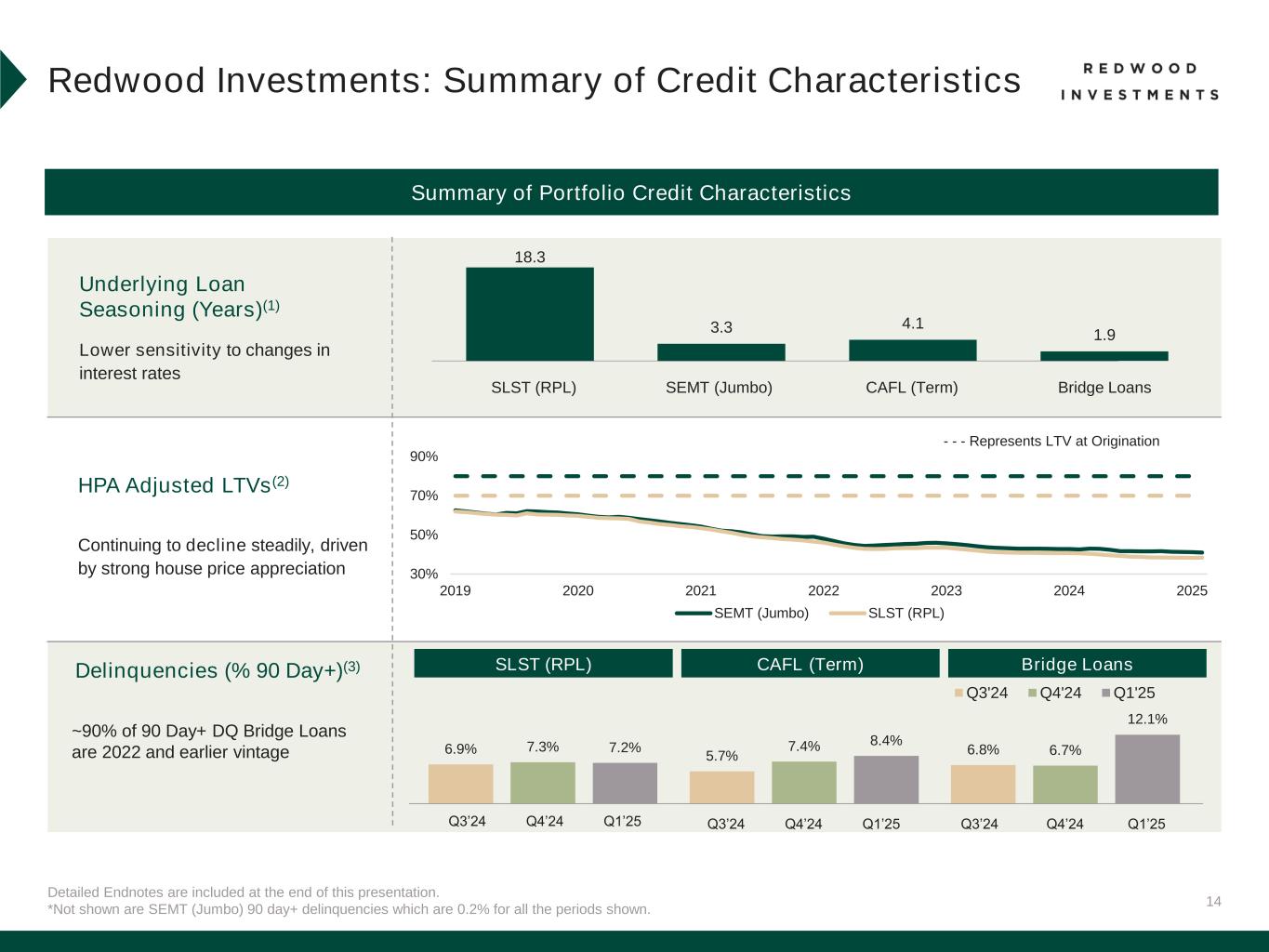
14 Detailed Endnotes are included at the end of this presentation. *Not shown are SEMT (Jumbo) 90 day+ delinquencies which are 0.2% for all the periods shown. Underlying Loan Seasoning (Years)(1) Delinquencies (% 90 Day+)(3) Summary of Portfolio Credit Characteristics - - - Represents LTV at Origination Lower sensitivity to changes in interest rates HPA Adjusted LTVs(2) Continuing to decline steadily, driven by strong house price appreciation ~90% of 90 Day+ DQ Bridge Loans are 2022 and earlier vintage SLST (RPL) SEMT (Jumbo) CAFL (Term) Bridge Loans 18.3 3.3 4.1 1.9 6.9% 5.7% 6.8%7.3% 7.4% 6.7%7.2% 8.4% 12.1% Q3'24 Q4'24 Q1'25 SLST (RPL) Bridge Loans Q3’24 Q4’24 Q1’25 CAFL (Term) Q3’24 Q4’24 Q1’25 Q3’24 Q4’24 Q1’25 Redwood Investments: Summary of Credit Characteristics 30% 50% 70% 90% 2019 2020 2021 2022 2023 2024 2025 SEMT (Jumbo) SLST (RPL)

15 Financial Results
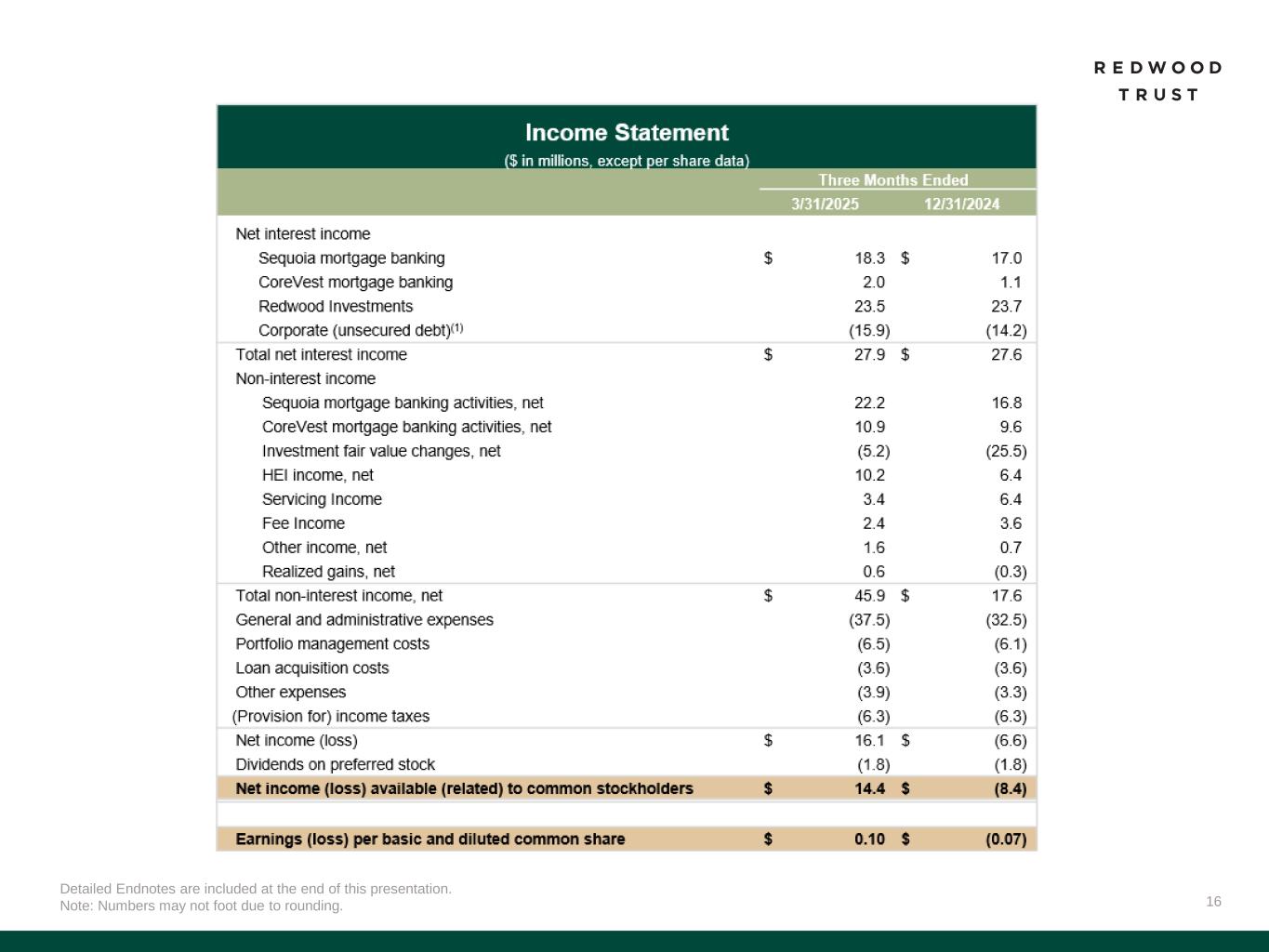
16 Detailed Endnotes are included at the end of this presentation. Note: Numbers may not foot due to rounding.
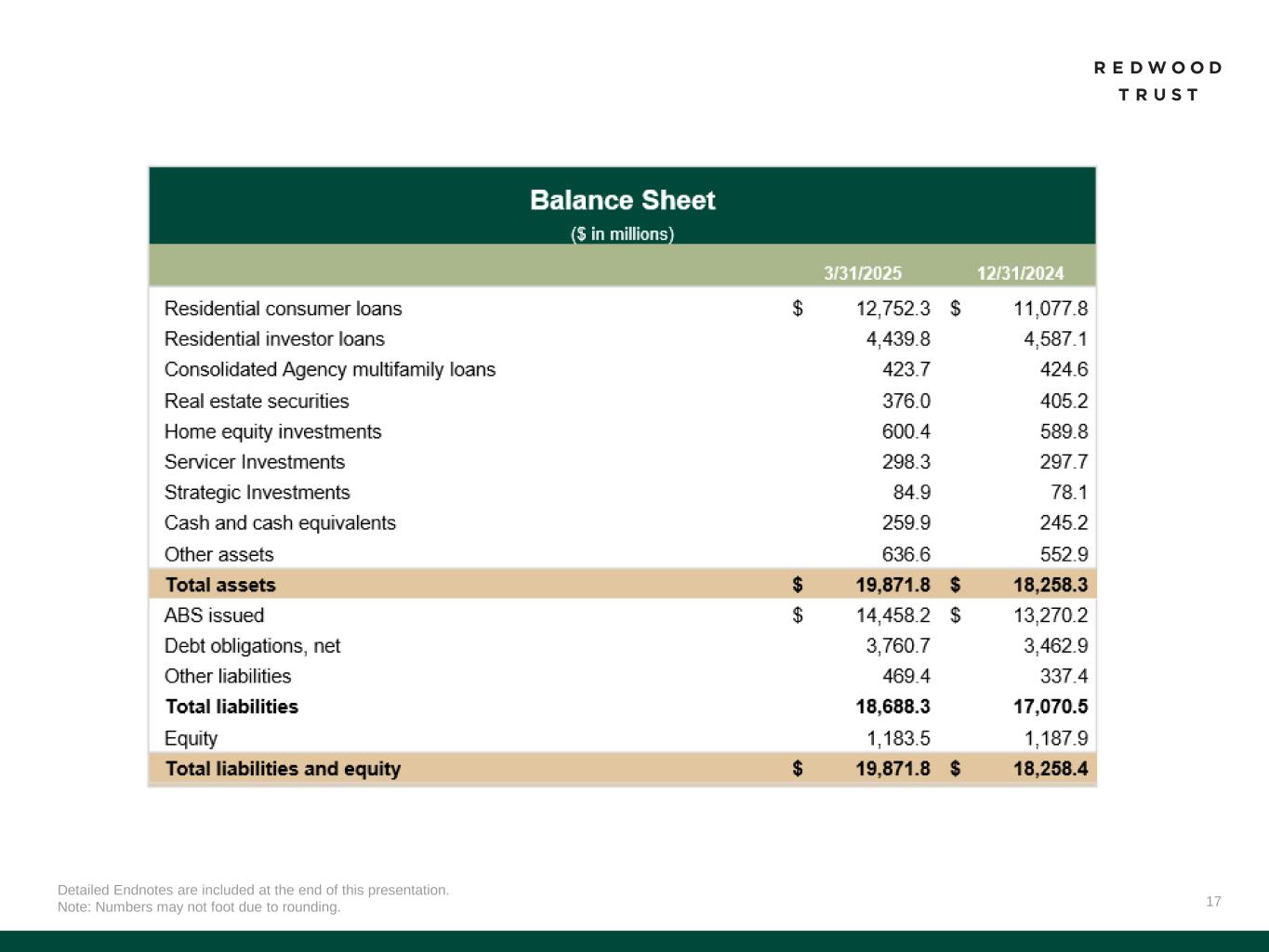
17 Detailed Endnotes are included at the end of this presentation. Note: Numbers may not foot due to rounding.
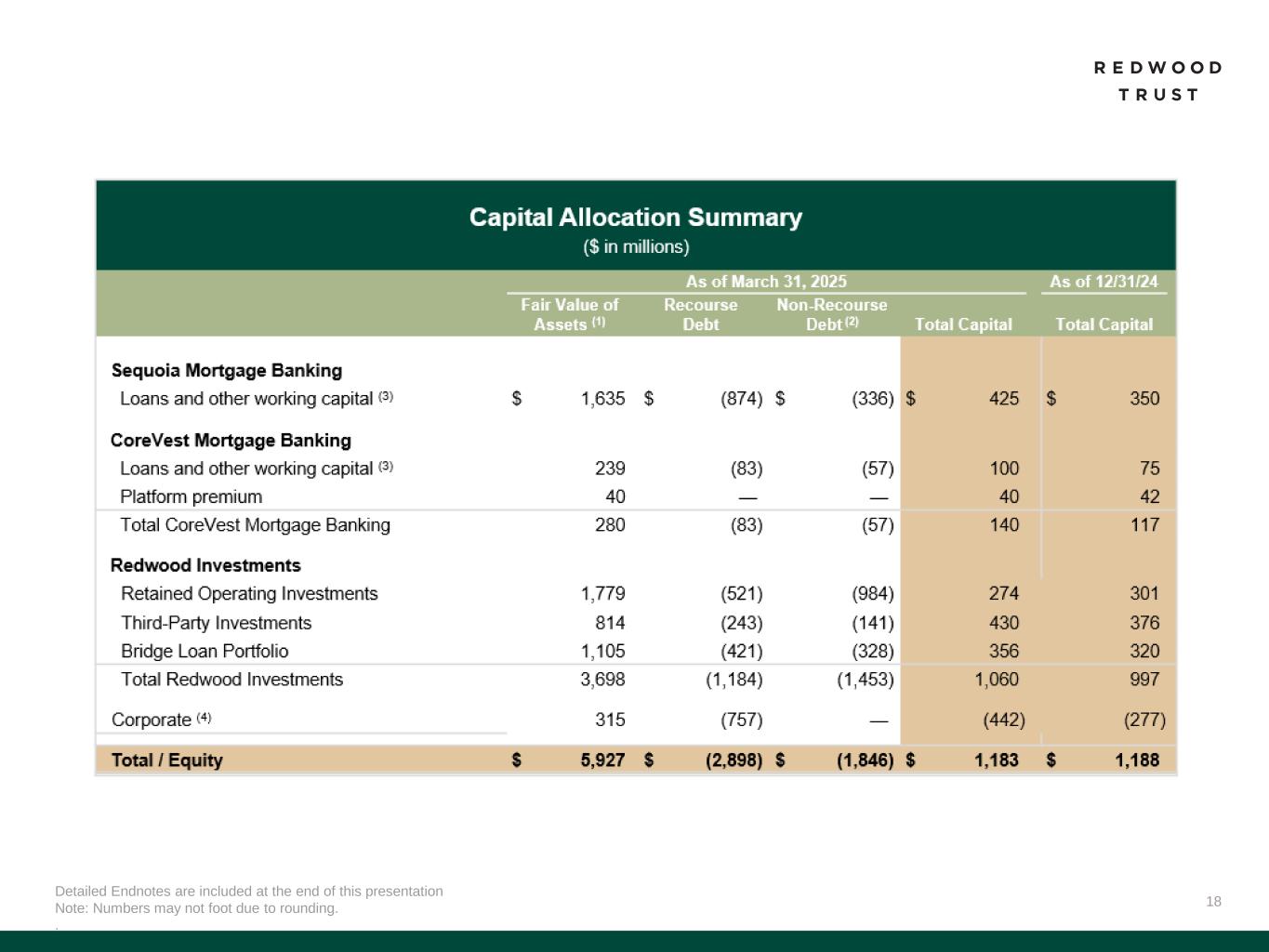
18 Detailed Endnotes are included at the end of this presentation Note: Numbers may not foot due to rounding. .
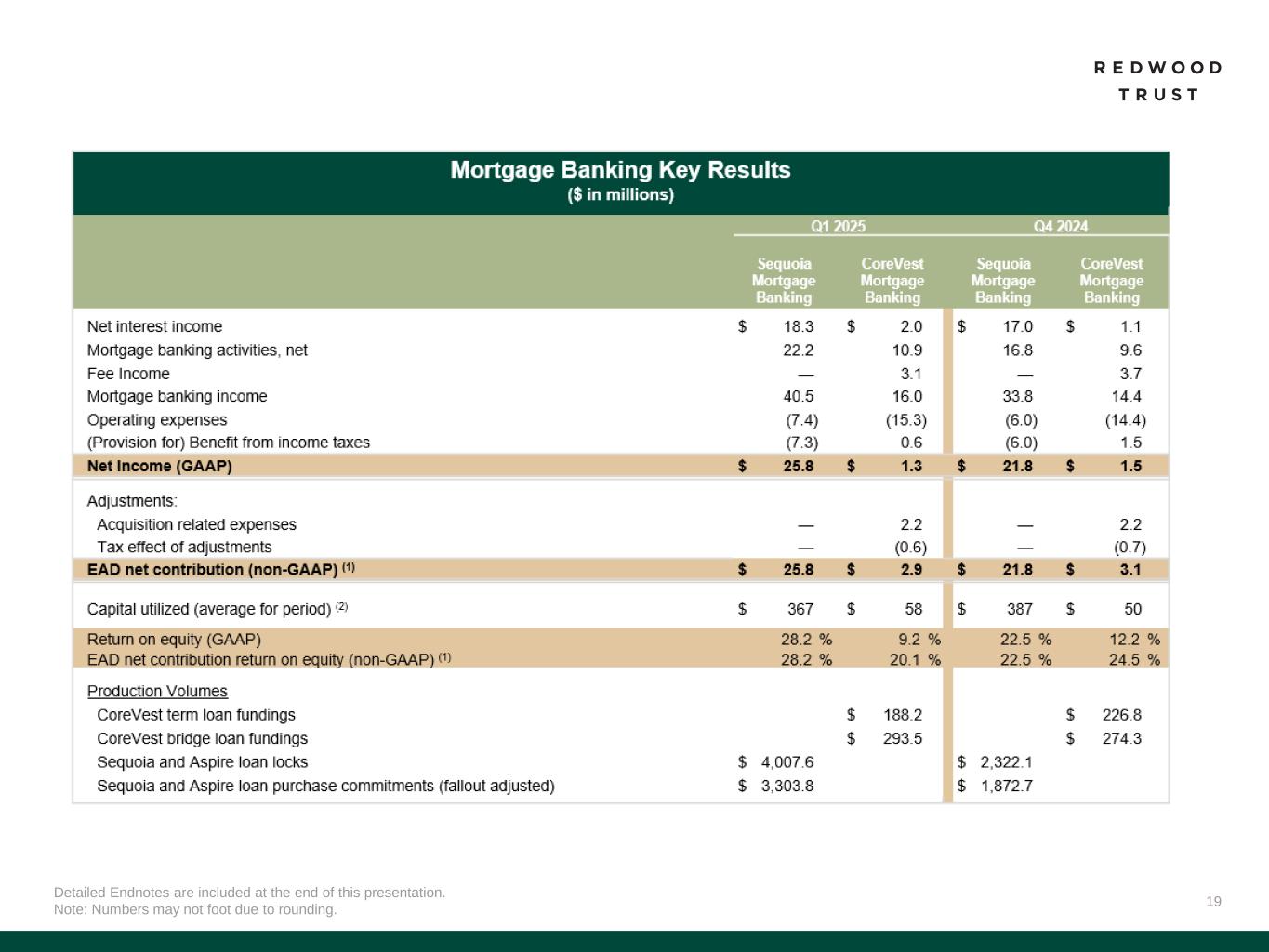
19 Detailed Endnotes are included at the end of this presentation. Note: Numbers may not foot due to rounding.
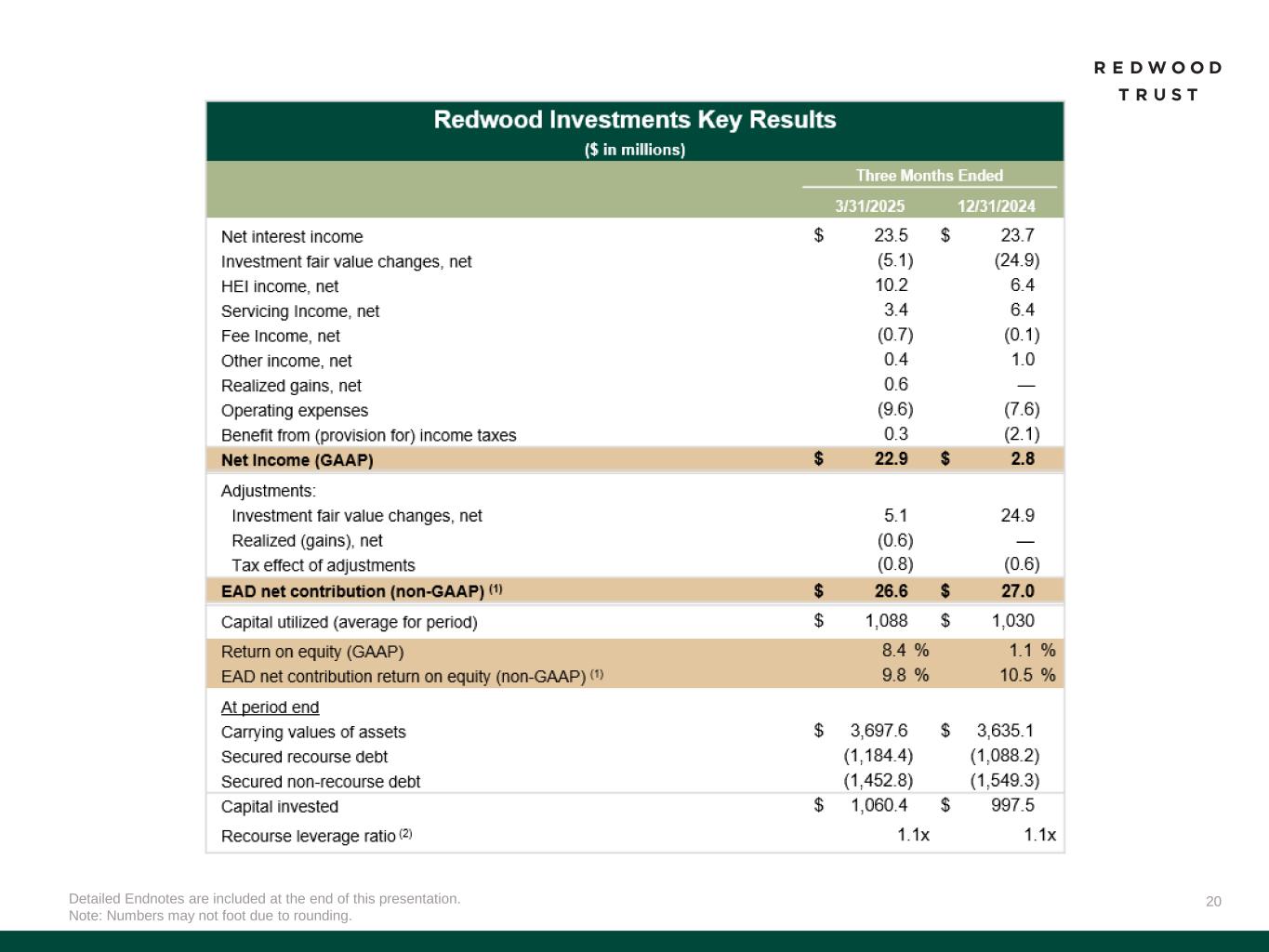
20Detailed Endnotes are included at the end of this presentation. Note: Numbers may not foot due to rounding.
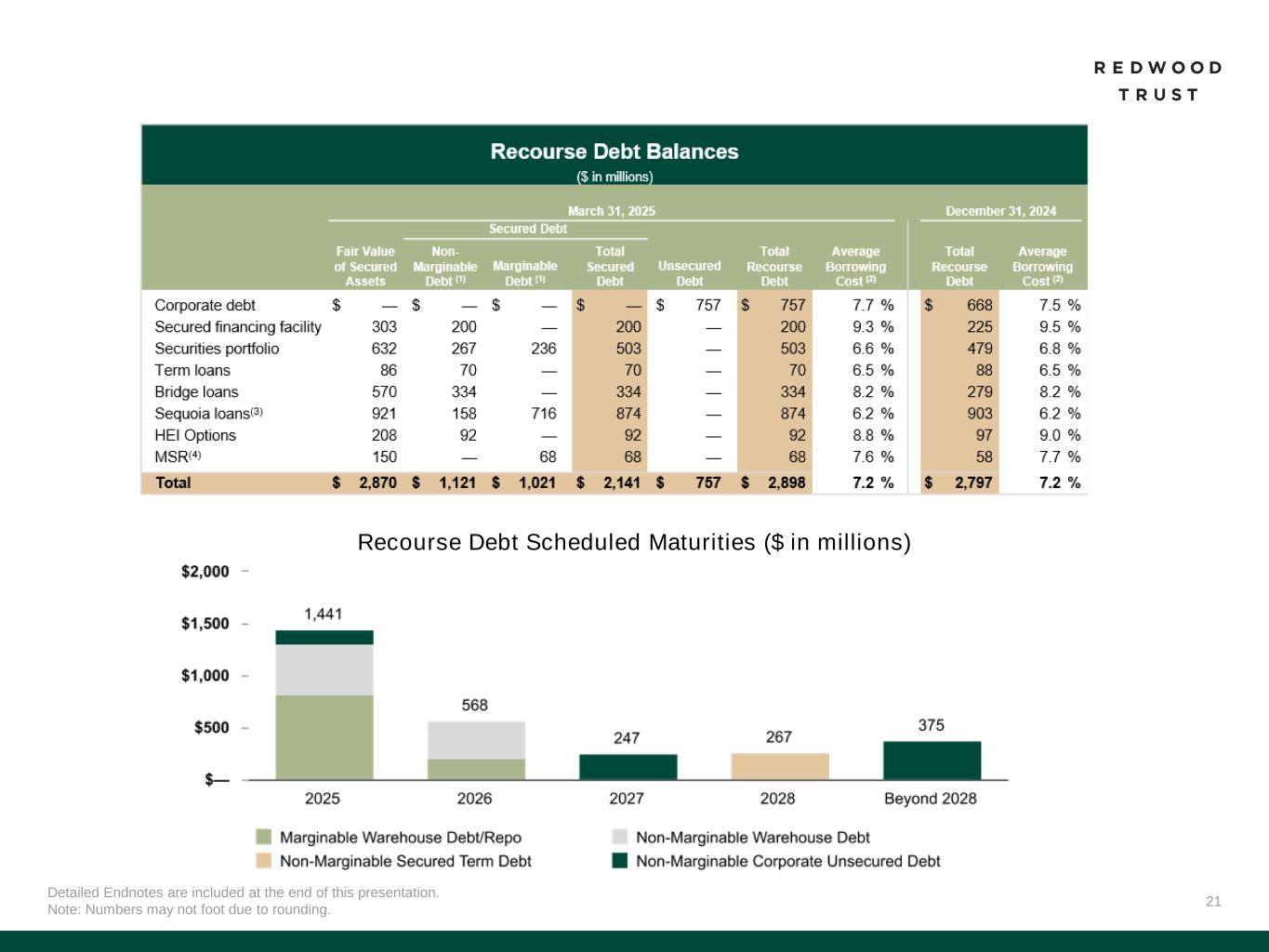
21 Detailed Endnotes are included at the end of this presentation. Note: Numbers may not foot due to rounding. Recourse Debt Scheduled Maturities ($ in millions)

22 Endnotes
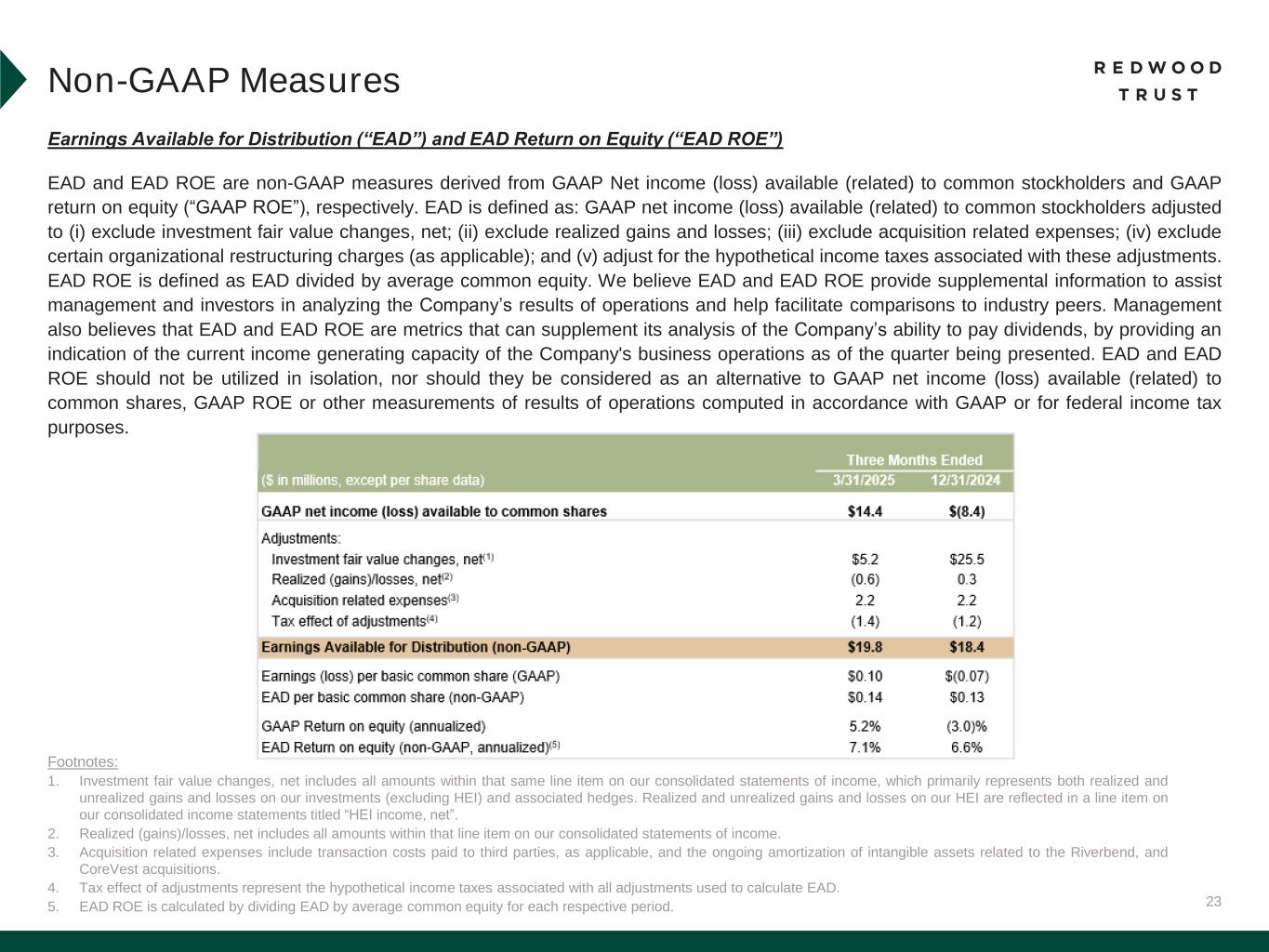
23 Earnings Available for Distribution (“EAD”) and EAD Return on Equity (“EAD ROE”) EAD and EAD ROE are non-GAAP measures derived from GAAP Net income (loss) available (related) to common stockholders and GAAP return on equity (“GAAP ROE”), respectively. EAD is defined as: GAAP net income (loss) available (related) to common stockholders adjusted to (i) exclude investment fair value changes, net; (ii) exclude realized gains and losses; (iii) exclude acquisition related expenses; (iv) exclude certain organizational restructuring charges (as applicable); and (v) adjust for the hypothetical income taxes associated with these adjustments. EAD ROE is defined as EAD divided by average common equity. We believe EAD and EAD ROE provide supplemental information to assist management and investors in analyzing the Company’s results of operations and help facilitate comparisons to industry peers. Management also believes that EAD and EAD ROE are metrics that can supplement its analysis of the Company’s ability to pay dividends, by providing an indication of the current income generating capacity of the Company's business operations as of the quarter being presented. EAD and EAD ROE should not be utilized in isolation, nor should they be considered as an alternative to GAAP net income (loss) available (related) to common shares, GAAP ROE or other measurements of results of operations computed in accordance with GAAP or for federal income tax purposes. Footnotes: 1. Investment fair value changes, net includes all amounts within that same line item on our consolidated statements of income, which primarily represents both realized and unrealized gains and losses on our investments (excluding HEI) and associated hedges. Realized and unrealized gains and losses on our HEI are reflected in a line item on our consolidated income statements titled “HEI income, net”. 2. Realized (gains)/losses, net includes all amounts within that line item on our consolidated statements of income. 3. Acquisition related expenses include transaction costs paid to third parties, as applicable, and the ongoing amortization of intangible assets related to the Riverbend, and CoreVest acquisitions. 4. Tax effect of adjustments represent the hypothetical income taxes associated with all adjustments used to calculate EAD. 5. EAD ROE is calculated by dividing EAD by average common equity for each respective period. Non-GAAP Measures
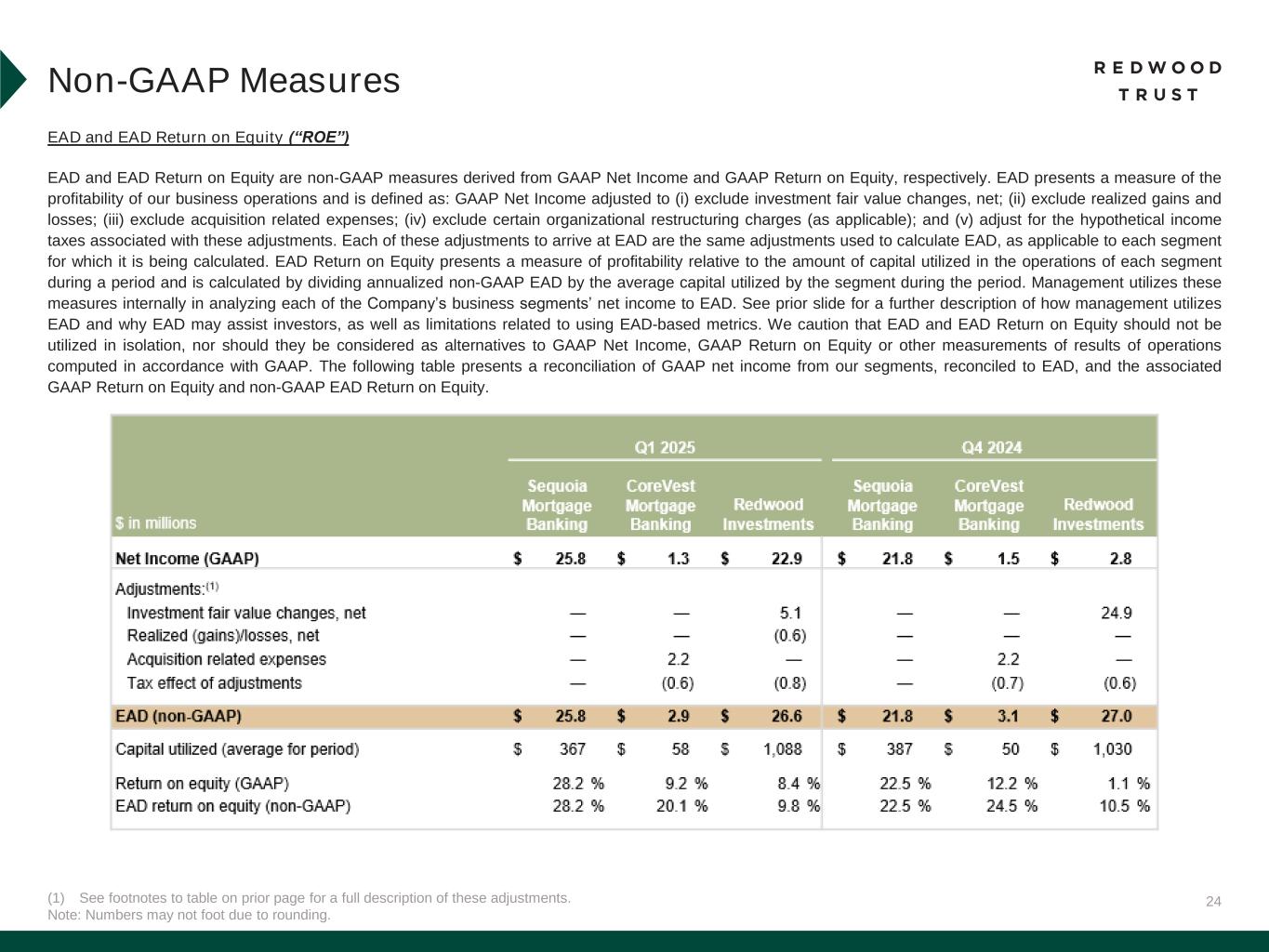
24 EAD and EAD Return on Equity (“ROE”) EAD and EAD Return on Equity are non-GAAP measures derived from GAAP Net Income and GAAP Return on Equity, respectively. EAD presents a measure of the profitability of our business operations and is defined as: GAAP Net Income adjusted to (i) exclude investment fair value changes, net; (ii) exclude realized gains and losses; (iii) exclude acquisition related expenses; (iv) exclude certain organizational restructuring charges (as applicable); and (v) adjust for the hypothetical income taxes associated with these adjustments. Each of these adjustments to arrive at EAD are the same adjustments used to calculate EAD, as applicable to each segment for which it is being calculated. EAD Return on Equity presents a measure of profitability relative to the amount of capital utilized in the operations of each segment during a period and is calculated by dividing annualized non-GAAP EAD by the average capital utilized by the segment during the period. Management utilizes these measures internally in analyzing each of the Company’s business segments’ net income to EAD. See prior slide for a further description of how management utilizes EAD and why EAD may assist investors, as well as limitations related to using EAD-based metrics. We caution that EAD and EAD Return on Equity should not be utilized in isolation, nor should they be considered as alternatives to GAAP Net Income, GAAP Return on Equity or other measurements of results of operations computed in accordance with GAAP. The following table presents a reconciliation of GAAP net income from our segments, reconciled to EAD, and the associated GAAP Return on Equity and non-GAAP EAD Return on Equity. (1) See footnotes to table on prior page for a full description of these adjustments. Note: Numbers may not foot due to rounding. Non-GAAP Measures
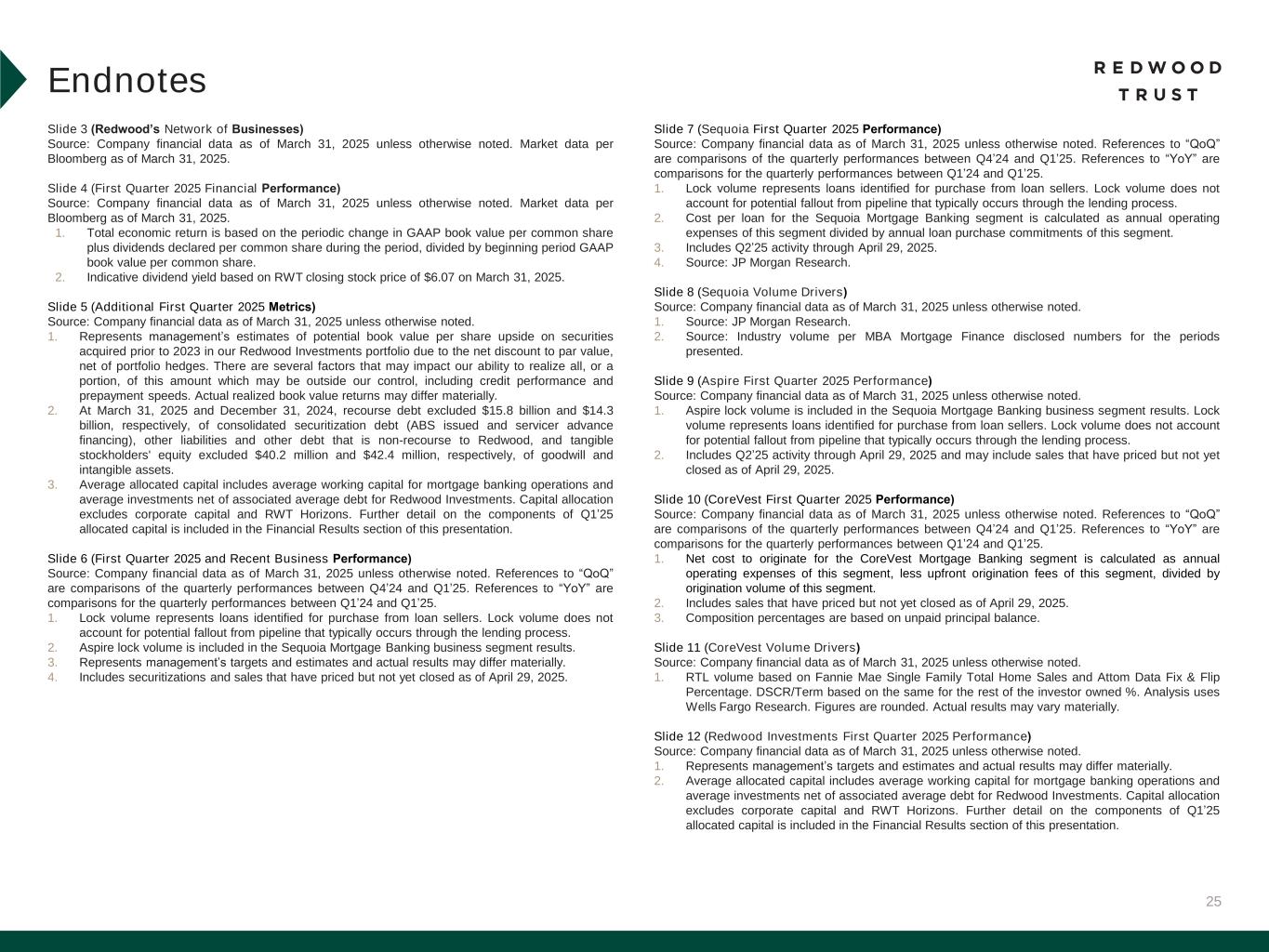
25 Slide 3 (Redwood’s Network of Businesses) Source: Company financial data as of March 31, 2025 unless otherwise noted. Market data per Bloomberg as of March 31, 2025. Slide 4 (First Quarter 2025 Financial Performance) Source: Company financial data as of March 31, 2025 unless otherwise noted. Market data per Bloomberg as of March 31, 2025. 1. Total economic return is based on the periodic change in GAAP book value per common share plus dividends declared per common share during the period, divided by beginning period GAAP book value per common share. 2. Indicative dividend yield based on RWT closing stock price of $6.07 on March 31, 2025. Slide 5 (Additional First Quarter 2025 Metrics) Source: Company financial data as of March 31, 2025 unless otherwise noted. 1. Represents management’s estimates of potential book value per share upside on securities acquired prior to 2023 in our Redwood Investments portfolio due to the net discount to par value, net of portfolio hedges. There are several factors that may impact our ability to realize all, or a portion, of this amount which may be outside our control, including credit performance and prepayment speeds. Actual realized book value returns may differ materially. 2. At March 31, 2025 and December 31, 2024, recourse debt excluded $15.8 billion and $14.3 billion, respectively, of consolidated securitization debt (ABS issued and servicer advance financing), other liabilities and other debt that is non-recourse to Redwood, and tangible stockholders' equity excluded $40.2 million and $42.4 million, respectively, of goodwill and intangible assets. 3. Average allocated capital includes average working capital for mortgage banking operations and average investments net of associated average debt for Redwood Investments. Capital allocation excludes corporate capital and RWT Horizons. Further detail on the components of Q1’25 allocated capital is included in the Financial Results section of this presentation. Slide 6 (First Quarter 2025 and Recent Business Performance) Source: Company financial data as of March 31, 2025 unless otherwise noted. References to “QoQ” are comparisons of the quarterly performances between Q4’24 and Q1’25. References to “YoY” are comparisons for the quarterly performances between Q1’24 and Q1’25. 1. Lock volume represents loans identified for purchase from loan sellers. Lock volume does not account for potential fallout from pipeline that typically occurs through the lending process. 2. Aspire lock volume is included in the Sequoia Mortgage Banking business segment results. 3. Represents management’s targets and estimates and actual results may differ materially. 4. Includes securitizations and sales that have priced but not yet closed as of April 29, 2025. Endnotes Slide 7 (Sequoia First Quarter 2025 Performance) Source: Company financial data as of March 31, 2025 unless otherwise noted. References to “QoQ” are comparisons of the quarterly performances between Q4’24 and Q1’25. References to “YoY” are comparisons for the quarterly performances between Q1’24 and Q1’25. 1. Lock volume represents loans identified for purchase from loan sellers. Lock volume does not account for potential fallout from pipeline that typically occurs through the lending process. 2. Cost per loan for the Sequoia Mortgage Banking segment is calculated as annual operating expenses of this segment divided by annual loan purchase commitments of this segment. 3. Includes Q2’25 activity through April 29, 2025. 4. Source: JP Morgan Research. Slide 8 (Sequoia Volume Drivers) Source: Company financial data as of March 31, 2025 unless otherwise noted. 1. Source: JP Morgan Research. 2. Source: Industry volume per MBA Mortgage Finance disclosed numbers for the periods presented. Slide 9 (Aspire First Quarter 2025 Performance) Source: Company financial data as of March 31, 2025 unless otherwise noted. 1. Aspire lock volume is included in the Sequoia Mortgage Banking business segment results. Lock volume represents loans identified for purchase from loan sellers. Lock volume does not account for potential fallout from pipeline that typically occurs through the lending process. 2. Includes Q2’25 activity through April 29, 2025 and may include sales that have priced but not yet closed as of April 29, 2025. Slide 10 (CoreVest First Quarter 2025 Performance) Source: Company financial data as of March 31, 2025 unless otherwise noted. References to “QoQ” are comparisons of the quarterly performances between Q4’24 and Q1’25. References to “YoY” are comparisons for the quarterly performances between Q1’24 and Q1’25. 1. Net cost to originate for the CoreVest Mortgage Banking segment is calculated as annual operating expenses of this segment, less upfront origination fees of this segment, divided by origination volume of this segment. 2. Includes sales that have priced but not yet closed as of April 29, 2025. 3. Composition percentages are based on unpaid principal balance. Slide 11 (CoreVest Volume Drivers) Source: Company financial data as of March 31, 2025 unless otherwise noted. 1. RTL volume based on Fannie Mae Single Family Total Home Sales and Attom Data Fix & Flip Percentage. DSCR/Term based on the same for the rest of the investor owned %. Analysis uses Wells Fargo Research. Figures are rounded. Actual results may vary materially. Slide 12 (Redwood Investments First Quarter 2025 Performance) Source: Company financial data as of March 31, 2025 unless otherwise noted. 1. Represents management’s targets and estimates and actual results may differ materially. 2. Average allocated capital includes average working capital for mortgage banking operations and average investments net of associated average debt for Redwood Investments. Capital allocation excludes corporate capital and RWT Horizons. Further detail on the components of Q1’25 allocated capital is included in the Financial Results section of this presentation.
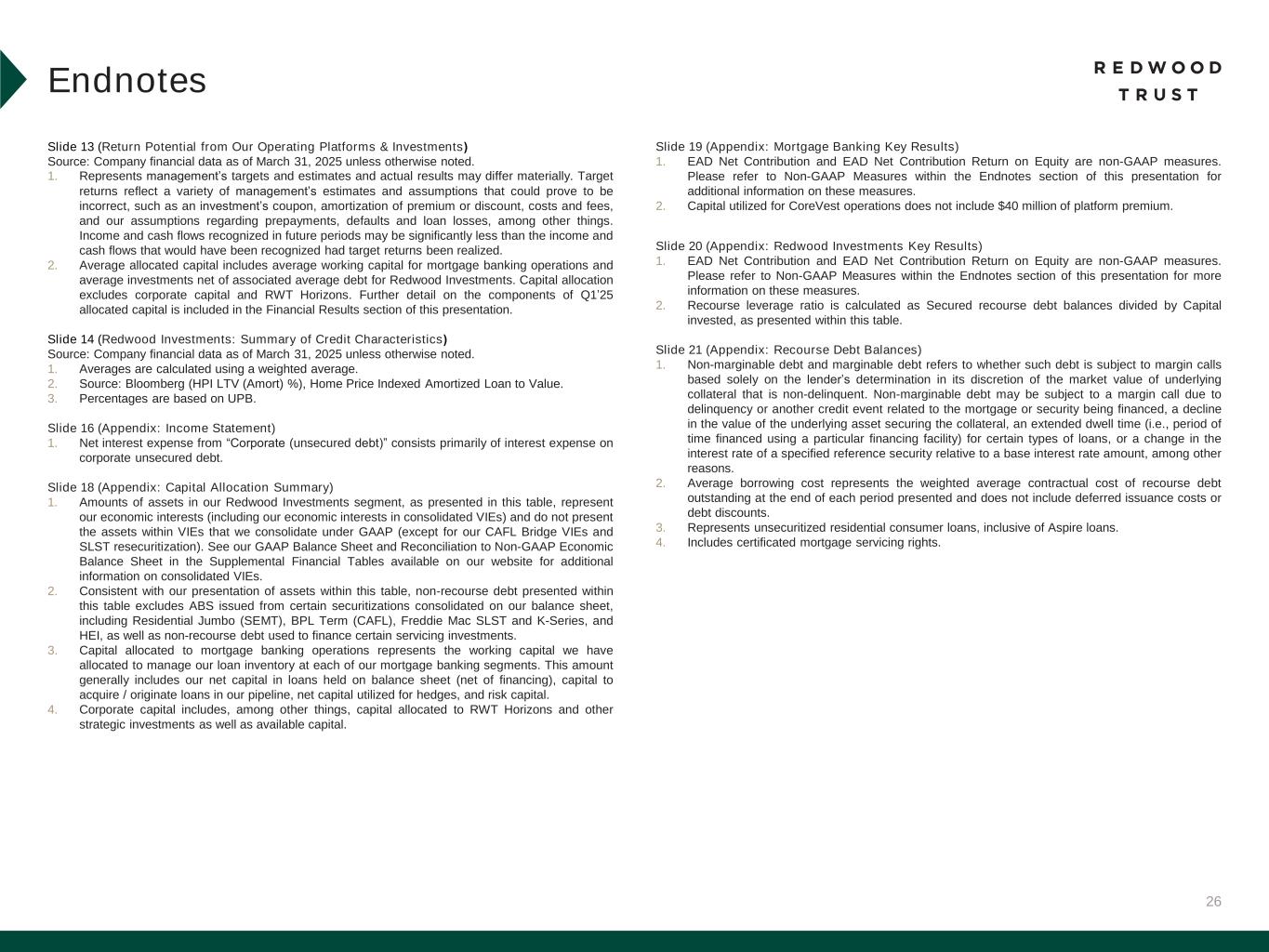
26 Slide 13 (Return Potential from Our Operating Platforms & Investments) Source: Company financial data as of March 31, 2025 unless otherwise noted. 1. Represents management’s targets and estimates and actual results may differ materially. Target returns reflect a variety of management’s estimates and assumptions that could prove to be incorrect, such as an investment’s coupon, amortization of premium or discount, costs and fees, and our assumptions regarding prepayments, defaults and loan losses, among other things. Income and cash flows recognized in future periods may be significantly less than the income and cash flows that would have been recognized had target returns been realized. 2. Average allocated capital includes average working capital for mortgage banking operations and average investments net of associated average debt for Redwood Investments. Capital allocation excludes corporate capital and RWT Horizons. Further detail on the components of Q1’25 allocated capital is included in the Financial Results section of this presentation. Slide 14 (Redwood Investments: Summary of Credit Characteristics) Source: Company financial data as of March 31, 2025 unless otherwise noted. 1. Averages are calculated using a weighted average. 2. Source: Bloomberg (HPI LTV (Amort) %), Home Price Indexed Amortized Loan to Value. 3. Percentages are based on UPB. Slide 16 (Appendix: Income Statement) 1. Net interest expense from “Corporate (unsecured debt)” consists primarily of interest expense on corporate unsecured debt. Slide 18 (Appendix: Capital Allocation Summary) 1. Amounts of assets in our Redwood Investments segment, as presented in this table, represent our economic interests (including our economic interests in consolidated VIEs) and do not present the assets within VIEs that we consolidate under GAAP (except for our CAFL Bridge VIEs and SLST resecuritization). See our GAAP Balance Sheet and Reconciliation to Non-GAAP Economic Balance Sheet in the Supplemental Financial Tables available on our website for additional information on consolidated VIEs. 2. Consistent with our presentation of assets within this table, non-recourse debt presented within this table excludes ABS issued from certain securitizations consolidated on our balance sheet, including Residential Jumbo (SEMT), BPL Term (CAFL), Freddie Mac SLST and K-Series, and HEI, as well as non-recourse debt used to finance certain servicing investments. 3. Capital allocated to mortgage banking operations represents the working capital we have allocated to manage our loan inventory at each of our mortgage banking segments. This amount generally includes our net capital in loans held on balance sheet (net of financing), capital to acquire / originate loans in our pipeline, net capital utilized for hedges, and risk capital. 4. Corporate capital includes, among other things, capital allocated to RWT Horizons and other strategic investments as well as available capital. Endnotes Slide 19 (Appendix: Mortgage Banking Key Results) 1. EAD Net Contribution and EAD Net Contribution Return on Equity are non-GAAP measures. Please refer to Non-GAAP Measures within the Endnotes section of this presentation for additional information on these measures. 2. Capital utilized for CoreVest operations does not include $40 million of platform premium. Slide 20 (Appendix: Redwood Investments Key Results) 1. EAD Net Contribution and EAD Net Contribution Return on Equity are non-GAAP measures. Please refer to Non-GAAP Measures within the Endnotes section of this presentation for more information on these measures. 2. Recourse leverage ratio is calculated as Secured recourse debt balances divided by Capital invested, as presented within this table. Slide 21 (Appendix: Recourse Debt Balances) 1. Non-marginable debt and marginable debt refers to whether such debt is subject to margin calls based solely on the lender’s determination in its discretion of the market value of underlying collateral that is non-delinquent. Non-marginable debt may be subject to a margin call due to delinquency or another credit event related to the mortgage or security being financed, a decline in the value of the underlying asset securing the collateral, an extended dwell time (i.e., period of time financed using a particular financing facility) for certain types of loans, or a change in the interest rate of a specified reference security relative to a base interest rate amount, among other reasons. 2. Average borrowing cost represents the weighted average contractual cost of recourse debt outstanding at the end of each period presented and does not include deferred issuance costs or debt discounts. 3. Represents unsecuritized residential consumer loans, inclusive of Aspire loans. 4. Includes certificated mortgage servicing rights.
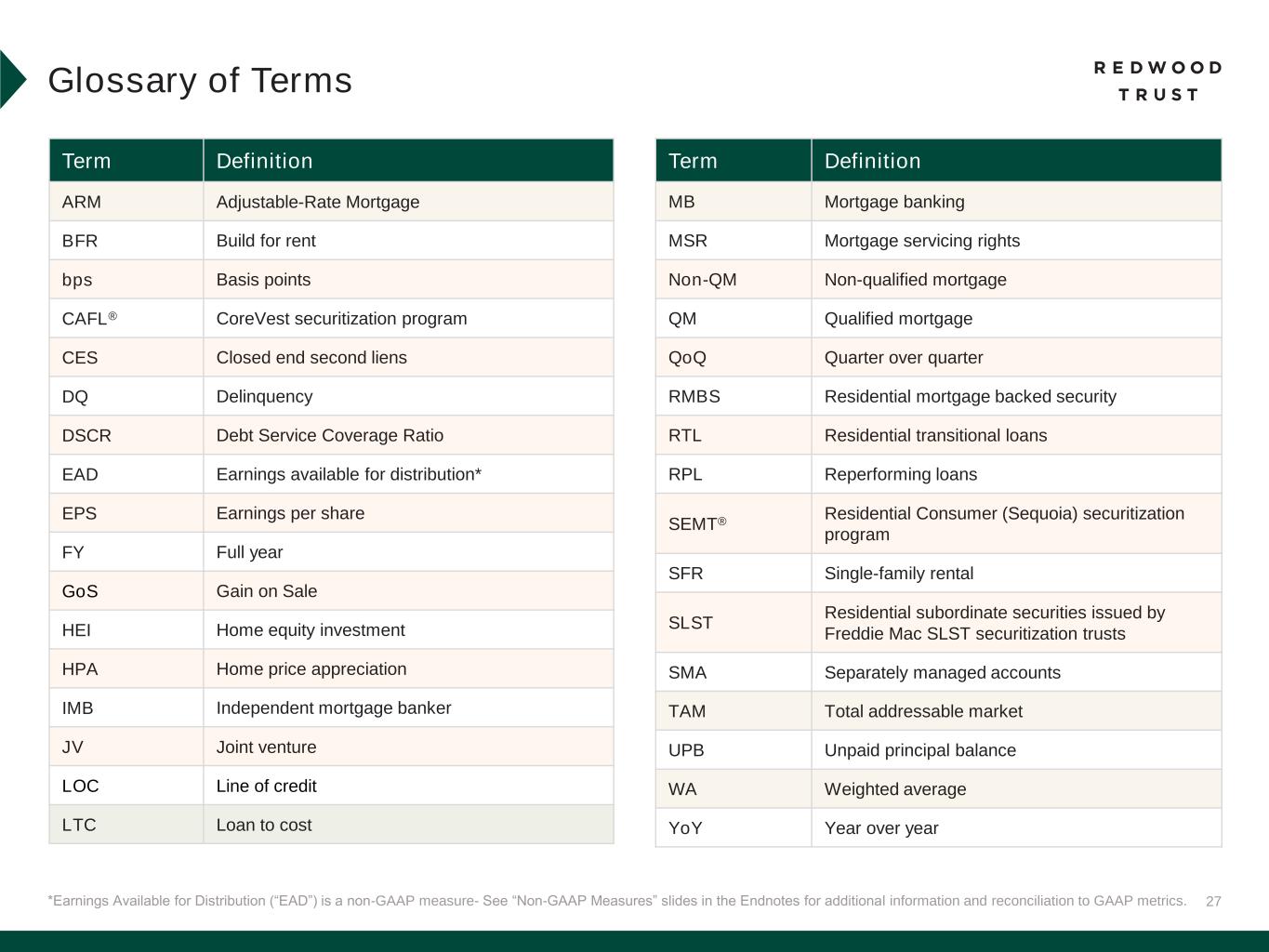
27*Earnings Available for Distribution (“EAD”) is a non-GAAP measure- See “Non-GAAP Measures” slides in the Endnotes for additional information and reconciliation to GAAP metrics. Glossary of Terms Term Definition ARM Adjustable-Rate Mortgage BFR Build for rent bps Basis points CAFL® CoreVest securitization program CES Closed end second liens DQ Delinquency DSCR Debt Service Coverage Ratio EAD Earnings available for distribution* EPS Earnings per share FY Full year GoS Gain on Sale HEI Home equity investment HPA Home price appreciation IMB Independent mortgage banker JV Joint venture LOC Line of credit LTC Loan to cost Term Definition MB Mortgage banking MSR Mortgage servicing rights Non-QM Non-qualified mortgage QM Qualified mortgage QoQ Quarter over quarter RMBS Residential mortgage backed security RTL Residential transitional loans RPL Reperforming loans SEMT® Residential Consumer (Sequoia) securitization program SFR Single-family rental SLST Residential subordinate securities issued by Freddie Mac SLST securitization trusts SMA Separately managed accounts TAM Total addressable market UPB Unpaid principal balance WA Weighted average YoY Year over year